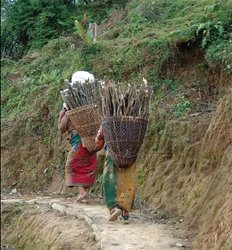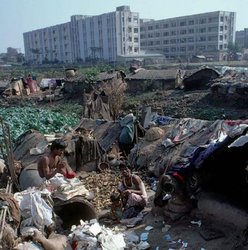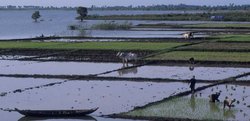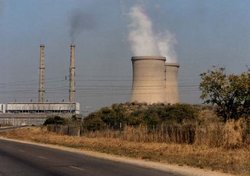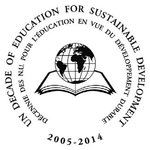Global Environment Outlook (GEO-4): Chapter 1
development is what we all do in attempting
to improve our lot within that abode.
The two are inseparable.”
Our Common Future
Contents
- 1 Chapter 1: Environment for Development (Global Environment Outlook (GEO-4): Chapter 1)
- 2 Main messages
- 3 Introduction
- 4 Our Common Future: Evolution of Ideas and Actions
- 5 Human Well-being and the Environment
- 6 Drivers of Change and Pressures
- 7 Globalization
- 8 Responses
- 9 Conclusion
- 10 Contributors
Chapter 1: Environment for Development (Global Environment Outlook (GEO-4): Chapter 1)
Main messages
It is 20 years since the report of the World Commission on Environment and Development (WCED), Our Common Future, emphasized the need for a sustainable way of life which not only addresses current environmental challenges but also ensures a secure society well into the future. This chapter analyses the evolution of such ideas as well as global trends in relation to environment and socioeconomic development. The following are its main messages:
The world has changed radically since 1987 – socially, economically and environmentally. Global population has grown by more than 1.7 billion, from about 5 billion people. The global economy has expanded and is now characterized by increasing globalization. Worldwide, GDP per capita (purchasing power parity) has increased from US$5 927 in 1987 to US$8 162 in 2004. However, growth has been distributed unequally betweenregions. Global trade has increased during the past 20 years, fuelled by globalization, better communication, and low transportation costs. Technology has also changed. Communications have been revolutionized with the growth of telecommunications and the Internet. Worldwide, mobile phone subscribers increased from 2 people per 1 000 in 1990 to 220 per 1 000 in 2003. Internet use increased from 1 person per 1 000 in 1990 to 114 per 1 000 in 2003. Finally, political changes have also been extensive. Human population and economic growth has increased demand on resources.
The World Commission on Environment and Development (WCED) recognized 20 years ago that the environment, economic and social issues are interlinked. It recommended that the three be integrated into development decision making. In defining sustainable development, the Commission acknowledged the need for both intra- and intergenerational equity – development that meets not only today’s human needs but also those of more people in the future.
Changing drivers, such as population (Human population explosion) growth, economic activities and consumption (Consumption and well-being) patterns, have placed increasing pressure on the environment. Serious and persistent barriers to sustainable development remain. In the past 20 years, there has been limited integration of environment into development decision making.
Environmental degradation is therefore undermining development and threatens future development progress. Development is a process that enables people to better their well-being. Long-term development can only be achieved through sustainable management of various assets: financial, material, human, social and natural. Natural assets, including water, soils, plants and animals, underpin people’s livelihoods.
Environmental degradation also threatens all aspects of human wellbeing. Environmental degradation has been demonstrably linked to human health problems, including some types of cancers, vector-borne diseases, emerging animal to human disease transfer, nutritional deficits and respiratory illnesses. The environment provides essential material assets and an economic base for human endeavour. Almost half the jobs worldwide depend on fisheries, forests or agriculture. Non-sustainable use of natural resources, including land, water, forests and fisheries, can threaten individual livelihoods as well as local, national and international economies. The environment can play a significant role in contributing to development and human well-being, but can also increase human vulnerability, causing human migration and insecurity, such as in the case of storms, droughts or environmental mismanagement. Environmental scarcity can foster cooperation, but also contribute to tensions or conflicts.
Environmental sustainability, Millennium Development Goal 7, is critical to the attainment of the other MDG goals. Natural resources are the basis of subsistence in many poor communities. In fact, natural capital accounts for 26 per cent of the wealth of low-income countries. Up to 20 per cent of the total burden of disease in developing countries is associated with environmental risks. Poor women are particularly vulnerable to respiratory infections related to exposure to indoor air pollution. Acute respiratory infections are the leading cause of death in children, with pneumonia killing more children under the age of five than any other illness. A combination of unsafe water and poor sanitation is the world’s second biggest killer of children. About 1.8 million children die annually and about 443 million school days are missed due to diarrhoea. Clean water and air are powerful preventative medicines. Sustainable management of natural resources contributes to poverty alleviation, helps reduce diseases and child mortality, improves maternal health, and can contribute to gender equity and universal education.
Some progress towards sustainable development has been made since 1987 when the WCED report, Our Common Future, was launched. The number of meetings and summits related to the environment and development has increased (for example, the 1992 Rio Earth Summit and the 2002 World Summit on Sustainable Development), and there has been a rapid growth in multilateral environmental agreements (for example, the Kyoto Protocol and the Stockholm Convention on Persistent Organic Pollutants). Sustainable development strategies have been implemented at local, national, regional and international levels. An increasing number of scientific assessments (for example, the Intergovernmental Panel on Climate Change) have contributed to a greater understanding of environmental challenges. In addition, proven and workable solutions have been identified for environmental problems that are limited in scale, highly visible and acute, (for example, industrial air and water pollution, local soil erosion and vehicle exhaust emission).
However, some international negotiations have stalled over questions of equity and responsibility sharing. Interlinkages between drivers and pressures on the global environment make solutions complex. As a result, action has been limited on some issues, for example, climate change, persistent organic pollutants, fisheries management, invasive alien species and species extinction.
Effective policy responses are needed at all levels of governance. While proven solutions continue to be used, action should also be taken to address both the drivers of change and environmental problems themselves. A variety of tools that have emerged over the past 20 years may be strategic. Economic instruments, such as property rights, market creation, bonds and deposits, can help correct market failures and internalize costs of protecting the environment. Valuation techniques can be used to understand the value of ecosystem services. Scenarios can provide insights on the future impacts of policy decisions. Capacity building and education are critical to generate knowledge and inform the decision making process.
Society has the capacity to make a difference in the way the environment is used to underpin development and human well-being. The following chapters highlight many of the challenges society faces today and provides signposts towards sustainable development.
Introduction
Imagine a world in which environmental change threatens people’s health, physical security, material needs and social cohesion. This is a world beset by increasingly intense and frequent storms (Global Environment Outlook (GEO-4): Chapter 1) , and by rising sea levels. Some people experience extensive flooding, while others endure intense droughts. Species extinction occurs at rates never before witnessed. Safe water is increasingly limited, hindering economic activity. Land degradation endangers the lives of millions of people.
This is the world today. Yet, as the World Commission on Environment and Development (Brundtland Commission) concluded 20 years ago “humanity has the ability to make development sustainable.” The fourth Global Environment Outlook highlights imperative steps needed to achieve this vision.
The fourth GEO assesses the current state of the world’s atmosphere (Atmospheric composition and structure), land, water and biodiversity, providing a description of the state of environment, and demonstrating that the environment is essential for improving and sustaining human well-being. It also shows that environmental degradation is diminishing the potential for sustainable development. Policies for action are highlighted to facilitate alternative development paths.
This chapter examines developments since the landmark 1987 Brundtland Commission report – Our Common Future – placed sustainable development much higher on the international policy agenda. It examines institutional developments and changes in thought since the mid-1980s, and explores the relationships involving environment, development and human well-being, reviews major environmental, social and economic trends, and their impacts on environment and human well-being, and provides options to help achieve sustainable development.
Subsequent chapters will analyse of environmental changes in the atmosphere, land, water and biodiversity, both at global and regional levels, and will highlight human vulnerability and strategic policy interlinkages for effective responses. Positive developments since 1987 are described. These include progress towards meeting the goals of the Montreal Protocol, and the reduction in emissions of chemicals that deplete the stratospheric ozone layer. Yet, the chapters also highlight current environmental trends that threaten human well-being:
- In some cases, climate change is having severe effects on human health, food production, security and resource availability.
- Extreme weather conditions are having an increasingly large impact on vulnerable human communities, particularly the world’s poor.
- Both indoor and outdoor pollution is still causing many premature deaths.
- Land degradation is decreasing agricultural productivity, resulting in lower incomes and reduced food security.
- Decreasing supplies of safe water are jeopardizing human health and economic activity.
- Drastic reductions of fish stocks are creating both economic losses and a loss of food supply.
- Accelerating species extinction rates are threatening the loss of unique genetic pools, possible sources for future medical and agricultural advances.
Choices made today will determine how these threats will unfold in the future. Reversing such adverse environmental trends will be an immense challenge. Ecosystem services collapse is a distinct possibility if action is not taken. Finding solutions to these problems today is therefore urgent.
This chapter provides a message for action today: The Earth is our only home. Its well-being, and our own, is imperilled. To ensure long-term wellbeing, we must take an alternative approach to development, one that acknowledges the importance of environment.
Our Common Future: Evolution of Ideas and Actions
Two decades ago the Brundtland Commission report – Our Common Future – addressed the links between development and environment, and challenged policy-makers to consider the interrelationships among environment, economic and social issues when it comes to solving global problems. The report examined emerging global challenges in:
- population and human resources
- food security;
- species and ecosystems;
- energy;
- industry; and
- urbanization
The commission recommended institutional and legal changes in six broad areas to address these challenges:
- getting at the resources;
- dealing with the effects;
- assessing global risks;
- making informed choices;
- providing the legal means; and
- investing in or future
Recommendations emphasized the expansion of international institutions for cooperation, and the creation of legal mechanisms for environmental protection and sustainable development, and also stressed the links between poverty and environmental degradation. They also called for increased capacity to assess and report on risks of irreversible damage to natural systems, as well as threats to human survival, security and well-being.
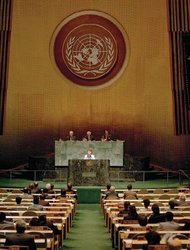
The work of the commission was built on the foundation of, among others, the 1972 UN Conference on the Human Environment in Stockholm and the 1980 World Conservation Strategy, which emphasized conservation as including both protection and the rational use of natural resources [1]. The Brundtland Commission is widely attributed with popularizing sustainable development internationally [2]. It defined sustainable development as “development that meets the needs of the present generation without compromising the ability of future generations to meet their own needs.” The commission further explained that, “the concept of sustainable development implies limits – not absolute limits but limitations imposed by the present state of technology and social organization on environmental resources and by the ability of the biosphere to absorb the effects of human activities.” It was argued that, “technology and social organization can be both managed and improved to make way for a new era of economic growth”[3].
The most immediate and perhaps one of the most significant results of Our Common Future was the organization of the UN Conference on Environment and Development (UNCED), also known as the Earth Summit, which gathered many heads of state in Rio de Janeiro in 1992. Not only did this meeting bring together 108 government leaders, more than 2 400 representatives from nongovernmental organizations (NGOs) attended, and 17 000 people participated in a parallel NGOs event. The Earth Summit strengthened interaction among governments, NGOs and scientists, and fundamentally changed attitudes towards governance and the environment. Governments were encouraged to rethink the concept of economic development, and to find ways to halt the destruction of natural resources and reduce pollution of the planet.
- social and economic issues, such as poverty, human health and population;
- conservation and management of natural resources including the atmosphere (Atmospheric composition and structure), forests, biological diversity, wastes and toxic chemicals;
- the role of nine major groups in implementing the sustainable development agenda (local authorities, women, farmers, children and youth, indigenous peoples, workers and trade unions, NGOs, the scientific and technological community, and business and industry); and
- means of implementation, including technology transfer, financing, science, education and public information.
Embedded in these four main areas of Agenda 21 are the environmental challenges, as well as the broad governance issues highlighted in the Brundtland Commission report. As the blueprint for sustainable development, Agenda 21 remains the most significant non-binding instrument in the environmental field [4].
Funding for the implementation of Agenda 21 was to be obtained from the Global Environment Facility (GEF). As a partnership involving the UNEP, UNDP, and World Bank, GEF was established the year before the Earth Summit to mobilize resources for projects that seek to protect the environment. Since 1991, the GEF has provided US$6.8 billion in grants, and generated more than US$24 billion in co-financing from other sources to support about 2,000 projects that produce global environmental benefits in more than 160 developing countries and countries with economies in transition. GEF funds are contributed by donor countries, and in 2006, 32 countries pledged a total of US$3.13 billion to fund various environment-related initiatives over four years [5].The turn of the century brought a sense of urgency to attempts to address environment and development challenges. World leaders sought to ensure a world free from want. In the Millennium Declaration, adopted in 2000, world leaders committed to free their people from the “threat of living on a planet irredeemably spoilt by human activities, and whose resources would no longer be sufficient for their needs” [6]. The Millennium Summit, adopted the declaration and created time-bound goals and targets – the [[Millennium Development Goal]s (MDGs)] – to better human well-being.
Two years after the Millennium Declaration and a decade after the Rio Earth Summit, world leaders reaffirmed sustainable development as a central goal on the international agenda at the 2002 Johannesburg World Summit on Sustainable Development (WSSD). More than 21 000 participants attended the summit, along with representatives of more than 191 governments. The UN Secretary-General designated five priority areas for discussion: water, including sanitation, energy, health, agriculture and biodiversity. These became to be known by the acronym WEHAB. These issues can also be traced back to initiatives such as the Brundtland Commission. The WSSD outcomes include the Johannesburg Declaration on Sustainable Development, and a 54-page plan of implementation. World leaders committed themselves, “to expedite the achievement of the time-bound, socio-economic and environmental targets” contained within the Plan of Implementation (Johannesburg Declaration on Sustainable Development). This historic summit also achieved new commitments on water and sanitation, poverty eradication, energy, sustainable production and consumption, chemicals, and management of natural resources [7].
The last 20 years has also seen a growth in the number of scientific assessments, such as the Intergovernmental Panel on Climate Change, the Millennium Ecosystem Assessment and the Global Environment Outlook. The Intergovernmental Panel on Climate Change was established in 1988 to assess on an objective, open and transparent basis the scientific, technical and socio-economic information relevant to climate change. In 2007, the IPCC released its Fourth Assessment Report (IPCC Fourth Assessment Report). The Millennium Ecosystem Assessment was called for by the then UN Secretary-General Kofi Annan, to assess the consequences of ecosystem change for human wellbeing. These scientific assessments reflect the work of thousands of experts worldwide, and have led to greater understanding of environmental problems.
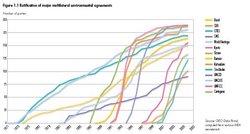
As a result of the conferences and assessments highlighted above, a diversity of multilateral environmental agreements (MEAs) have been adopted (see Figure 1.1), and these and several others are analysed in relevant Chapters (Global Environment Outlook (GEO-4): Chapter 1) throughout this report. The Convention on Biological Diversity (CBD) was signed by 150 government leaders at the Montreal Protocol. The CBD sets out commitments for conserving biodiversity, the sustainable use of its components, and fair and equitable sharing of its benefits. The Cartagena Protocol on Biosafety is based on the precautionary approach from the Rio Declaration. Principle 15 of the Rio Declaration states that, “where there are threats of serious and irreversible damage lack of full scientific certainty shall not be used as a reason for postponing cost effective measures to prevent biological degradation” [9]. The Protocol promotes biosafety in the handling, transfer and use of living modified organisms.
Two agreements that have drawn significant attention during the last 20 years are the Montreal Protocol to the the Ozone Layer and the Kyoto Protocol to the UN Framework Convention on Climate Change. The Montreal Protocol, which became effective in 1989 and had 191 parties at the beginning of 2007, has helped decrease or stabilize atmospheric concentrations of many of the ozone-depleting substances, including chlorofluorocarbons. The protocol is regarded as one of the most successful international agreements to date. By contrast, despite the urgency of climate change, it has been much more difficult to get some countries responsible for significant emissions of greenhouse gases to ratify the Kyoto Protocol.
Environmental governance has changed since the Brundtland Commission. Today, a broader scope of issues related to environment and development are discussed. The issues of trade, economic development, good governance, transfer of technology, science and education policies, and globalization, which links them together, have become even more central to sustainable development.
Different levels of government participate in environmental policy. The post-WCED period saw a strong increase in sub-national and local government action, for example, through local Agenda 21 processes. The Johannesburg Plan of Implementation stressed that the role of national policies and development strategies “cannot be overemphasized.” It also strengthened the role of the regional level, for example by giving the regional UN economic commissions new tasks, and establishing a regional preparation process for the Commission on Sustainable Development (CSD) [10].
The number of non-governmental stakeholders involved in environmental governance has grown considerably, with organizations playing key roles from local to global levels. NGOs and advocacy groups devoted to public interest and environmental causes have multiplied exponentially, particularly in countries undertaking democratic transitions [11].
The private sector should also take action to help protect the environment. Even though business was “given little attention by the WCED …, more boards and executive committees are trying to consider all dimensions of their impacts at once, on the same agenda, in the same room” [12]. As consumer demand for “green” products arose, some businesses developed voluntary environmental codes, or followed codes developed by nongovernmental organizations and governments [13]. Other companies began to monitor and report on their sustainability impacts. A study by eight corporate leaders on what business success would look like in the future concluded that it would be tied to helping society cope with challenges such as poverty, globalization, environmental decline and demographic change [14].
|
Box 1.1 Environment as the foundation for development[15] |
|
Development is the process of furthering people’s well-being. Good development entails:
The environment is central to all four of these requirements. Long-term development can only be achieved through sustainable management of various assets: financial, material, human, social and natural. Natural assets, including water, soils, plants and animals, underpin the livelihoods of all people. At the national level, natural assets account for 26 per cent of the wealth of low-income countries. Sectors such as agriculture, fishery, forestry, tourism and minerals provide important economic and social benefits to people. The challenge lies in the proper management of these resources. Sustainable development provides a framework for managing human and economic development, while ensuring a proper and optimal functioning over time of the natural environment. |
Finally, decision making is increasingly participatory. Stakeholder groups interact with each other and with governments through networks, dialogues and partnerships. Interaction among groups at local, national and global levels was institutionalized in the action plans of UNCED and WSSD. Chapter 37 of Agenda 21 urged countries to involve all possible interest groups in building national consensus on Agenda 21 implementation, and Chapter 28 encouraged local authorities to engage in dialogue with their citizens.
Environment as the foundation for development
Before the Brundtland Commission, “development progress” was associated with industrialization, and measured solely by economic activity and increases in wealth. Environmental protection was perceived by many as an obstacle to development. However, Our Common Future recognized “environment or development” as a false dichotomy. Focus shifted to “environment and development,” and then to “environment for development (see Box 1.1).” Principle 1 of Agenda 21 states: “Human beings are at the centre of concerns for sustainable development. They are entitled to a healthy and productive life in harmony with nature.”
The normative framework for human development is reflected by the MDGs [16]. In signing on to the MDGs, nations explicitly recognized that achieving Goal 7 on environmental sustainability is key to achieving poverty eradication. However, environmental issues are not highly integrated into other MDGs [17]. A healthy environment is essential for achieving all the goals (see Table 1.1). To achieve real progress, the interlinkages between MDG 7 and the other MDGs need to be acknowledged and integrated into all forms of planning.
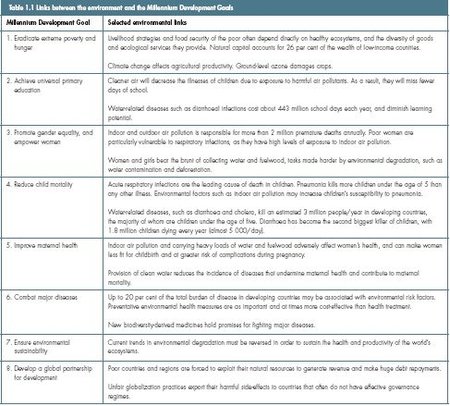
While a healthy environment can support development, the relationship is not always reciprocal. Many alternative views exist on the benefits and disadvantages of modern development [19]. It has been argued that development is destructive, even violent, to nature [20]. As GEO-4 illustrates, past development practices have often not been beneficial to the environment. However, opportunities exist to make development sustainable.
Environmental degradation due to development raises deep ethical questions that go beyond economic cost-benefit ratios. The question of justice is perhaps the greatest moral question emerging in relation to environmental change and sustainable development. Growing evidence indicates that the burden of environmental change is falling far from the greatest consumers of environmental resources, who experience the benefits of development. Often, people living in poverty in the developing world, suffer the negative effects of environmental degradation. Furthermore, costs of environmental degradation will be experienced by humankind in future generations. Profound ethical questions are raised when benefits are extracted from the environment by those who do not bear the burden.
Barriers to sustainable development
Despite changes in environmental governance, and greater understanding of the links between environment and development, real progress towards sustainable development has been slow. Many governments continue to create policies concerned with environmental, economic and social matters as single issues. There is a continued failure to link environment and development in decision making [21]. As a result, development strategies often ignore the need to maintain the very ecosystem services on which long-term development goals depend. A notable example, made apparent in the aftermath of the 2005 Hurricane Katrina, is the failure of some government agencies to see the link between destruction of coastal wetlands and the increased vulnerability of coastal communities to storms (Tropical weather and hurricanes) [22]. For many, acknowledging that environmental change could endanger future human well-being is inconvenient, as it requires an uncomfortable level of change to individual and working lives [23].
International negotiations on solutions to global environmental problems have frequently stalled over questions of equity [24]. For instance, in the case of climate change, international negotiations have slowed down over the question on how to share responsibilities and burden among nations, given different historic and current levels of national emissions.
Providing widespread participation in sustainable development decision making called for by Agenda 21 has also raised significant challenges. The enormous diversity of issues that need to be considered in sustainable development policy making, together with aspirations for transparency, make public participation design daunting. If participation is treated superficially, and embodied merely as a quota of specified groups in decision making processes, it could easily be no more than “lip service.” The task of designing modern, crosscutting, transparent, evidence-based interdisciplinary decision making is not only conceptually challenging, but also necessitates a huge increase in local capacity for democracy and decision making [25].
Many social, economic and technological changes described later in this chapter have made implementation of the recommendations in Our Common Future difficult. As also illustrated in other chapters, changes such as a growing population and increased consumption of energy have had a huge impact on the environment, challenging society’s ability to achieve sustainable development.
Finally, the nature of the environmental problems has influenced the effectiveness of past responses. Environmental problems can be mapped along a continuum from “problems with proven solutions” to “less known emerging (or persistent) problems” [26]. With problems with proven solutions, the cause-and-effect relationships are well known. The scale tends to be local or national. Impacts are highly visible and acute, and victims are easily identified. During the past 20 years, workable solutions have been identified for several such problems, for example industrial air and water pollution, local soil erosion, mangrove clearance for aquaculture, and vehicle exhaust emissions.
However, progress has been limited on harder to manage environmental issues, which can also be referred to as “persistent” problems [27]. These are deeply rooted structural problems, related to the ways production and consumption are conducted at the household, national, regional and global levels. Harder to manage problems tend to have multiple dimensions and be global in scale. Some of the basic science of cause-and-effect relationships is known, but often not enough to predict when a tipping point or a point of no return will be reached. There is often a need to implement measures on a very large-scale. Examples of such problems include global climate change, persistent organic pollutants and heavy metals, ground level ozone, acid rain, large-scale deterioration of fisheries, extinction of species, or introductions of alien species. Awareness of the nature of an environmental problem provides a basis for creating strategies, targeting efforts, and finding and implementing a sustainable solution. Possible solutions to different types of environmental problems are introduced in the last section of this chapter, highlighted in the rest of the report, and discussed further in Chapter 10 (Global Environment Outlook (GEO-4): Chapter 1).
Human Well-being and the Environment
For sustainable development to be achieved, links between the environment and development must be examined. It is also important to consider the end point of development: human well-being. The evolution of ideas on development has made the concept of human well-being central to the policy debate. Human well-being is the outcome of development. Human well-being and the state of the environment are strongly interlinked. Establishing how environmental changes have impacts on human well-being, and showing the importance of environment for human well-being, are among the core objectives of this report.
Defining human well-being
Defining human well-being (see Box 1.2) is not easy, due to alternative views on what it means. Simply put, human well-being can be classified according to three views, each of which has different implications for the environment:
- The resources people have, such as money and other assets. Wealth is seen as conducive to well-being. This view is closely linked to the concept of weak sustainability, which argues that environmental losses can be compensated for by increases in physical capital (machines) [28]. The environment can only contribute to development as a means to promote economic growth.
- How people feel about their lives (their subjective views). Individuals’ assessments of their own living conditions take into account the intrinsic importance that environment has for life satisfaction. According to this view, people value the environment for its traditional or cultural aspects [29].
- What people are able to be and to do. This view focuses on what the environment allows individuals to be and to do [30]. It points out that the environment provides the basis for many benefits, such as proper nourishment, avoiding unnecessary morbidity and premature mortality, enjoying security and self-respect, and taking part in the life of the community. The environment is appreciated beyond its role as income generator, and its impacts on human well-being are seen as multidimensional.
|
Box 1.2 Human well-being[31] |
|
Human well-being is the extent to which individuals have the ability and the opportunity to live the kinds of lives they have reason to value. People’s ability to pursue the lives that they value is shaped by a wide range of instrumental freedoms. Human well-being encompasses personal and environmental security, access to materials for a good life, good health and good social relations, all of which are closely related to each other, and underlie the freedom to make choices and take action:
Increasing the real opportunities that people have to improve their lives requires addressing all these components. This is closely linked to environmental quality and the sustainability of ecosystem services. Therefore, an assessment of the impact of the environment on individuals’ well-being can be done by mapping the impact of the environment on these different components of well-being. |
The evolution of these ideas has progressed from the first to the third, with increasing importance being given to the real opportunities that people have to achieve what they wish to be and to do. This new understanding of human well-being has several important aspects. First, multidimensionality is viewed as an important feature of human wellbeing. Consequently, the impact of the environment on human well-being is seen according to many different dimensions.
Second, autonomy is considered a defining feature of people, and of well-being. Autonomy can be defined broadly as allowing people to make individual or collective choices. In other words, to know whether an individual is well requires considering his or her resources, subjective views, and the ability to choose and act. This concept of human well-being highlights the importance of understanding whether individuals are simply passive spectators of policy interventions, or, in fact, active agents of their own destiny.
Context of human well-being
The potential for individuals, communities and nations to make their own choices, and maximize opportunities to achieve security and good health, meet material needs and maintain social relations is affected by many interlinked factors, such as poverty, inequality and gender. It is important to note how these factors relate to each other, and to the environment.
Poverty and inequality
Poverty is understood as a deprivation of basic freedoms. It implies a low level of well-being, with such outcomes as poor health, premature mortality and morbidity, and illiteracy. It is usually driven by inadequate control over resources, discrimination (including by race or gender), and lack of access to material assets, health care and education [32].
Inequality refers to the skewed distribution of an object of value, such as income, medical care or clean water, among individuals or groups. Unequal access to environmental resources remains an important source of inequality among individuals. Equity is the idea that a social arrangement addresses equality in terms of something of value. Distributive analysis is used to assess features of human well-being that are unequally distributed among individuals according to arbitrary factors, such as gender, age, religion and ethnicity. When an analysis of this distribution focuses on its lower end, it refers to poverty.
Mobility
When seen in a dynamic perspective, inequality and poverty are better understood through the concepts of social mobility and vulnerability. Mobility relates to the ability of people to move from one social group, class or level to another. Environmental degradation may be responsible for locking individuals within lowmobility paths, limiting opportunities to improve their own well-being.
Vulnerability
Vulnerability involves a combination of exposure and sensitivity to risk, and the inability to cope or adapt to environmental change. Most often, the poor are more vulnerable to environmental change. Broad patterns of vulnerability to environmental and socio-economic changes can be identified so that policy-makers can respond, providing opportunities for reducing vulnerability, while protecting the environment. Chapter 7 (Global Environment Outlook (GEO-4): Chapter 1) assesses the vulnerability of the human-environment system to multiple stresses (drivers and pressures).
Gender inequality
An analysis of distributive impacts of the environment on human well-being cannot ignore features such as gender. Gender inequality is one of the most persistent inequalities in both developed and developing countries, with the majority of people living in poverty being women [33]. Women and girls often carry a disproportionate burden from environmental degradation compared to men. Understanding the position of women in society, and their relationship with the environment is essential for promoting development. In many cases, women and girls assume greater responsibilities for environmental management, but have subordinate positions in decision making [34]. Women need to be at the centre of policy responses [35]. At the same time, it is important to avoid stereotyping these roles, and to base responses on the complexities of local realities [36].
Environmental change and human well-being
One of the main findings of the Millennium Ecosystem Assessment is that the relationship between human well-being and the natural environment is mediated by services provided by ecosystems (see Box 1.3). Changes to these services, as a result of changes in the environment, affect human well-being through impacts on security, basic material for a good life, health, and social and cultural relations [37]. All people – rich and poor, urban and rural, and in all regions – rely on natural capital.
|
Box 1.3 Ecosystem services[38] |
|
Ecosystem services include provisioning services, such as food and water; regulating services, such as flood and disease control; cultural services, such as spiritual, recreational and cultural benefits; and supporting services, such as nutrient cycling that maintain the conditions for life on Earth (see Table 5.2 in Chapter 5 (Global Environment Outlook (GEO-4): Chapter 1) for details). |
The world’s poorest people depend primarily on environmental goods-and-services for their livelihoods, which makes them particularly sensitive and vulnerable to environmental changes [39]. Furthermore, many communities in both developing and developed countries derive their income from environmental resources, which include fisheries, non-timber forest products and wildlife.
Health
Shortly before the publication of Our Common Future, the nuclear accident at Chernobyl illustrated the catastrophic impact pollution can have on health. Twenty years later, as victims of Chernobyl still struggle with disease, the health of countless other people around the world continues to be affected by human-induced changes to the environment. Changes affecting provisioning services, including water, can influence human health. Changes affecting regulating services influence health via the distribution of disease transmitting insects or pollutants in water and air [40]. Almost one-quarter of all diseases are caused by environmental exposure [41].
As described in Chapter 2 (Global Environment Outlook (GEO-4): Chapter 1), urban air pollution is one of the most widespread environmental problems, affecting health in almost all regions of the world. While air pollution has decreased in many industrialized countries, it has increased in other regions, particularly in Asia. Here, rapid population growth, economic development and urbanization have been associated with increasing use of fossil fuels, and a deterioration of air quality. WHO estimates that more than 1 billion people in Asian countries are exposed to air pollutant levels exceeding their guidelines ([42]. In 2002, WHO estimated that more than 800 000 people died prematurely due to PM10 (particulate matter with a diameter less than 10 micrometers) outdoor pollution and 1.6 million due to PM10 indoor air pollution [43] (see [[Chapter 2 (Global Environment Outlook (GEO-4): Chapter 1)]2]).
|
Box 1.4 Wild meat trade[44] |
|
The bushmeat trade in Central Africa, and wildlife [[market]s] in Asia are examples of activities that both have impacts on the environment, and carry risk of disease emergence. In Viet Nam, the illegal trade in wildlife currently generates US$20 million/year. Wild meat is a critical source of protein and income for forest dwellers and rural poor. However, commercial demand for wild meat has been growing as a result of urban consumption, from wildlife restaurants and medicine shops, but also from markets in neighbouring countries. Rates of wildlife harvesting are unsustainable, and threaten species such as the small-toothed palm civet with extinction. In wildlife markets, mammals, birds and reptiles come in contact with dozens of other species and with countless numbers of people, increasing opportunity for disease transmission. Not surprisingly, during the 2003 sudden Acute Respiratory Syndrome (SARS) epidemic, several of the early patients in Guangdong Province, China, worked in the sale or preparation of wildlife for food. The disease may have first spread to humans from civet cats or bats in local wildlife markets. Through human air travel, SARS quickly spread to 25 countries across five continents. With more than 700 million people travelling by air annually, disease outbreaks can easily grow into worldwide epidemics.  Commercial demand for wild meat has been growing and rates of wildlife harvesting are unsustainable. (Credit: Lise Albrechtse)]] Commercial demand for wild meat has been growing and rates of wildlife harvesting are unsustainable. (Credit: Lise Albrechtse)]]
It is estimated that every year between 1.1 and 3.4 million tonnes of undressed wild animal biomass, or bushmeat, are consumed by people living the Congo Basin. The wild meat trade, commercial hunting of wild animals for meat, has decimated endangered populations of long-lived species such as chimpanzees. Trade is global in nature, and primate meat has even been found in [[market]s] in Paris, London, Brussels, New York, Chicago, Los Angeles, Montreal and Toronto. Contact with primate blood and bodily fluids during hunting and butchering has exposed people to novel viruses. Between 2000 and 2003, 13 of 16 Ebola outbreaks in Gabon and the Republic of Congo resulted from the handling of gorilla or chimpanzee carcasses. A recent study documents simian foamy virus (SFV) and human T-lymphotic (HTLV) viruses in individuals engaged in bushmeat hunting in rural Cameroon. |
Chapter 4 (Global Environment Outlook (GEO-4): Chapter 1) highlights how the overexploitation and pollution of freshwater ecosystems – rivers, lakes, wetlands and groundwater – has direct impacts on human well-being. Although access to clean water and sanitation has improved, in 2002 more than 1.1 billion people lacked access to clean water, and 2.6 billion lacked access to improved sanitation [45]. Annually, 1.8 million children die from diarrhoea, making the disease the world’s second biggest killer of children [46]. Many heavy metals, such as mercury and lead, are found in water and sediments, and are a major concern as they can accumulate in the tissues of humans and other organisms [47]. Numerous activities contribute to heavy metal contamination. Burning coal, incineration, urban and agricultural run-off, industrial discharges, small-scale industrial activities, mining, and landfill leakages are among the main ones described in Chapters 2, 3 and 4.
Changes in the environment have also resulted in the emergence of diseases. Since 1980, more than 35 infectious diseases have emerged or taken on new importance. These include previously unknown, emerging diseases, such as HIV, SARS and avian influenza (H5N1), as well as diseases once thought controllable, such as dengue fever, malaria and bubonic plague [48]. Human-induced changes to the environment, such as climate change, land use change and interaction with wildlife (see Box 1.4), have driven this recent epidemiological transition [49]. Growing human contact with wildlife, caused by population pressure on remaining relatively undisturbed environmental resources, increases the opportunity for pathogen exchange [50]. Globalization, in turn, has an effect on disease emergence as disease agents have the opportunity to move into new niches, and meet new, vulnerable populations. A recent UNEP report on Avian Influenza and the Environment states: “If the transfer of Asian lineage H5N1 between domestic flocks and wild birds is to be reduced, it will become essential to take measures to minimize their contact. Restoring wetland health will reduce the need for migrating wild birds to share habitat with domestic poultry” [51].
Material needs
People depend on natural resources for their basic needs, such as food, energy, water and housing. In many communities, particularly in developing countries, environmental resources, including fisheries, timber, non-timber forest products and wildlife, directly contribute to income and other material assets required to achieve a life that one values. The ability to meet material needs is strongly linked to the provisioning, regulating and supporting services of ecosystems [52].
More than 1.3 billion people depend on fisheries, forests and agriculture for employment – close to half of all jobs worldwide (see Box 1.5) [53]. In Asia and the Pacific, small-scale fisheries contributed 25 per cent to the total fisheries production of Malaysia, the Philippines, and Thailand for the decade ending in 1997 [54]. In Africa, more than 7 in 10 people live in rural areas, with most engaged in resource-dependent activities [55]. The corresponding small-scale production accounts for a significant percentage of the GDP in many African countries [56]. Moreover, smallscale agriculture accounts for more than 90 per cent of Africa’s agricultural production [57]. A study of households in the Masvingo province in southeast Zimbabwe indicates that 51 per cent of incomes are from agriculture, and that the total income from the environment averages 66 per cent [58]. Where resources are degraded, livelihoods are placed at risk. Forest loss may reduce the availability of food, energy resources and other forest products, which, in many communities, support trade and income earning opportunities.
|
Box 1.5 Material well-being from fisheries[59] |
|
The fisheries sector plays an important role in material well-being, providing income generation, poverty alleviation and food security in many parts of the world. Fish is an important protein source, especially in the developing world, providing more than 2.6 billion people with at least 20 per cent of their average per capita animal protein intake. The world’s population (Human population explosion) growth outpaced that of total fish supply and FAO projections indicate that a global shortage is expected (see [[Chapter 4 (Global Environment Outlook (GEO-4): Chapter 1)]2]). While fish consumption increased in some regions, such as South East Asia, Europe and North America, it declined in others, including sub-Saharan Africa and Eastern Europe. The collapse of the Canadian east coast cod fishery in the late 1980s had devastating impacts on local fishing communities, and illustrates that developed countries are not immune to the economic implications of mismanaging natural resources. It resulted in unemployment (Employment, unemployment, and well-being) for 25,000 fishers and 10,000 other workers (see Box 5.2 and Figure 7.17 in Chapters 5 and 7 (Global Environment Outlook (GEO-4): Chapter 1) respectively). |
Increasing evidence shows that investment in ecosystem conservation, such as watershed management, results in increased income for the rural poor. In the Adgaon watershed in India, the annual days of employment (wage labour) per worker increased from 75 days before watershed rehabilitation to 200 days after restoration was completed [60]. In Fiji, strengthening the traditional “no-take” management system to promote recovery of marine life has resulted in a 35–43 per cent increase in income over a period of three years (see Box 7.13) [61]. In a pioneering people-led watershed management project in India, the implementation of a participatory restoration scheme led to halving the distance to the water table, a doubling of land under irrigation, and an increase in the total agricultural income of the village from about US$55 000 in 1996, before watershed regeneration, to about US$235 000 in 2001 [62].
Security
Security incorporates economic, political, cultural, social and environmental aspects [63]. It includes freedom from threats of bodily harm, and from violence, crime and war. It means having stable and reliable access to resources, the ability to be secure from natural and human disasters, and the ability to mitigate and respond to shocks and stresses. Environmental resources are a critical part of the livelihoods of millions of people, and when these resources are threatened through environmental change, people’s security is also threatened. “At the centre of sustainable development is the delicate balance between human security and the environment” [64].
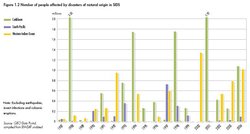
The Earth has shown clear signs of warming over the past century. Eleven of the last 12 years (1995–2006) rank among the 12 warmest years in the instrumental record of global surface temperature (since 1850) [66]. As [[Chapter 2 (Global Environment Outlook (GEO-4): Chapter 1)]3] describes, climate change is very likely to affect ecological regulating services, resulting in increased frequency and intensity of extreme weather hazards in many regions around the globe [67], and greater insecurity for much of the world’s population [68]. The impacts of extreme weather events will fall disproportionately upon developing countries, such as Small Island Developing States (SIDS) (see Figure 1.2), as well as on the poor in all countries [69]. During Hurricane Katrina in the United States in 2005, impoverished people without access to private transportation were unable to leave the city. People in poor health or lacking bodily strength were less likely to survive the Indian Ocean tsunami in 2004. For example, in villages in North Aceh, Indonesia, women constituted up to 80 per cent of deaths [70]. In Sri Lanka, a high mortality rate was also observed among other vulnerable groups: children and the elderly [71].
Environmental change can also affect security through changes in provisioning services, which supply food and other goods. Scarcity of shared resources has been a source of conflict and social instability [72]. Disputes over water quantity and quality are ongoing in many parts of the world. The apparent degradation of Easter Island’s natural resources by its Polynesian inhabitants, and the ensuing struggle between clans and chiefs, provides a graphic illustration of a society that destroyed itself by overexploiting scarce resources [73]. Natural resources can play an important role in armed conflicts. They have often been a means of funding war (see Box 1.6). Armed conflicts have also been used as a means to gain access to resources [74], and they can destroy environmental resources.
|
Box 1.6 Conflict in Sierra Leone and Liberia, and refugee settlement in Guinea[75] |
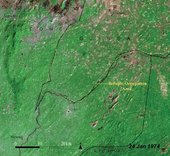 Credit: UNEP 2005b[76] Natural resources, including diamonds and timber, helped fuel civil war in Liberia and Sierra Leone during the 1990s. Diamonds were smuggled from Sierra Leone into Liberia and onto the world market. In the mid-1990s, Liberia’s official diamond exports ranged between US$300 and US$450 million annually. These diamonds have been referred to as “blood diamonds,” as their trade helped finance rebel groups and the continued hostilities. By the end of the war in 2002, more than 50,000 people had died, 20,000 were left mutilated and three-quarters of the population had been displaced in Sierra Leone alone. 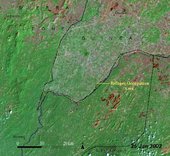 Credit: UNEP 2005b[77] As civil wars raged in Sierra Leone and Liberia, hundreds of thousands of refugees fled to safety in Guinea. In 2003, about 180,000 refugees resided in Guinea. Between Sierra Leone and Liberia, there is a small strip of land belonging to Guinea known as the “Parrot’s Beak,” because of the parrot shape contour of the international border between the countries (depicted as a black line on both images). This strip is where refugees constituted up to 80 per cent of the local population. The 1974 image shows small, evenly spread, scattered flecks of light green in the dark green forest cover of the Parrot’s Beak and surrounding forests of Liberia and Sierra Leone. These flecks are village compounds, with surrounding agricultural plots. The dark areas in the upper left of the image are most likely burn scars. In the 2002 image Parrot’s Beak is clearly visible as a more evenly spread light grey and green area surrounded by darker green forest of Liberia and Sierra Leone. The light colours show deforestation in the “safe area” where refugees had set up camp. Many of the refugees integrated into local villages, creating their own family plots by cutting more trees. As a result the isolated flecks merged into one larger area of degraded forest. The forest devastation is especially obvious in the upper left part, where areas that were green in 1974 now appear grey and brown, also due to expanded logging. |
Insecurity caused by bad governance or war can contribute to environmental degradation. Security requires the current and future availability of environmental goods-and-services, through good governance, mechanisms for conflict avoidance and resolution, and for disaster prevention, preparedness and mitigation [78]. Inequitable governance and institutions may prevent people from having secure livelihoods, as illustrated by land tenure conflicts in Southern Africa [79], and by poor management in Indonesia’s peat swamps [80]. In both examples, the resource is closely linked to local livelihoods, and insecurity is a result not so much of scarcity but of unequal access to and distribution of these vital resources. In other cases, as illustrated in Box 1.6, degradation may result from changes in settlement patterns as people are forced to flee an area due to hostilities or war.
|
Box 1.7 Chemicals affect Arctic peoples[81] |
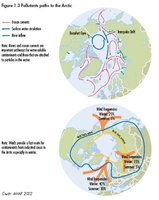 Figure 1.3 Pollutants paths to the Arctic.[82] As described in Chapters 5 and 6 (Global Environment Outlook (GEO-4): Chapter 1), the relationships that indigenous peoples have with the environment play an important role in their identity and overall well-being. Scientific assessments have detected persistent organic pollutants (POPs) and heavy metals in all components of the Arctic ecosystem, including in people. The majority of these substances are present in the ecosystems and diets of Arctic peoples as a result of choices (such as using the insecticide toxaphene on cotton fields) by industrial societies elsewhere. Contaminants reach the Arctic from all over the world through wind, air (Global-scale circulation of the atmosphere) and water currents (see Figure 1.3), entering the food chain. Inuit populations in the eastern Canadian Arctic and Greenland have among the highest exposures to POPs and mercury from a traditional diet of populations anywhere. A sustainable lifestyle, with ancient roots in the harvesting, distribution and consumption of local renewable resources, is endangered as a result. |
It has become clear in recent years that joint management on environmental matters is needed to facilitate cooperation across societal and international boundaries to avoid conflict [83]. The case of cooperative endeavours to deal with fisheries decline in Lake Victoria is an excellent example. Cooperation on water management and transnational ecosystems can also foster diplomatic habits of consultation and dialogue with positive political results, suggesting that human and environmental security are very closely linked [84].
Social relations
The environment also affects social relations by providing cultural services, such as the opportunity to express aesthetic, cultural or spiritual values associated with ecosystems [85]. The natural world provides opportunities for observation and education, recreation and aesthetic enjoyment, all of which are of value to a given society. In some communities, the environment underpins the very structure of social relations. As described in [[Chapter 5 (Global Environment Outlook (GEO-4): Chapter 1)]2], many cultures, particularly indigenous ones, are deeply interwoven with the local environment.
Climate change is a major concern for SIDS and their high cultural diversity; SIDS are imperilled by sea-level rise and increases in the intensity and number of storms [86] (see [[Chapter 7 (Global Environment Outlook (GEO-4): Chapter 1)]2]). Tuvalu is an example of an island vulnerable to environmental change. Even though its culture is strongly related to the local environment, the islanders may have to consider relocating to other countries to escape rising sea level as a result of climate change. Coping mechanisms embedded in such cultures might be lost, making society less resilient to future natural disasters [87].
A diet of traditional foods plays a particularly important role in the social, cultural, nutritional and economic health of indigenous peoples living in the Arctic [88]. Hunting, fishing, and the gathering of plants and berries are associated with important traditional values and practices that are central to their identity as indigenous peoples. Their traditional food is compromised by environmental contaminants (see Box 1.7 and Figure 1.3) and climate change (see Chapter 6 (Global Environment Outlook (GEO-4): Chapter 1)), and this affects all dimensions of indigenous wellbeing. The issue becomes magnified in light of the lack of accessible, culturally acceptable and affordable alternatives. Store food is expensive, and lacks cultural significance and meaning. Long-term solutions require that Arctic lifestyles be considered when development choices are made in industrial and agricultural regions around the world [89].
Drivers of Change and Pressures
Environmental changes and the effects on human wellbeing are induced by various drivers and pressures. Drivers such as demographic changes, economic demand and trade, science and technology, as well as institutional and socio-political frameworks induce pressures which, in turn, influence the state of the environment with impacts on the environment itself, and on society and economic activity. Most pressures on ecosystems result from, for example, changes in emissions, land use and resource extraction. Analyses of the linkages shown by the drivers-pressures-state-impacts-responses (DSPIR) framework (described in the Reader’s Guide to the report) form the foundation on which the GEO-4 assessment is constructed. In the two decades since the Brundtland Commission, these drivers and pressures have changed, often at an increasing rate. The result is that the environment has changed dramatically. No region has been spared the reality of a changing environment, and its immediate, short- and long-term impacts on human well-being.
Population
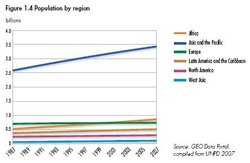
Population is an important driver behind environmental change, leading to increased demand for food, water and energy, and placing pressure on natural resources. Today’s population (Human population explosion) is three times larger than it was at the beginning of the 20th century. During the past 20 years global population has continued to rise, increasing from 5 billion in 1987 to 6.7 billion in 2007 (see Figure 1.4), with an average annual growth rate of 1.4 per cent. However, large differences in growth are evident across regions, with Africa and West Asia recording high growth rates, and the European population stabilizing (see [[Chapter 6 (Global Environment Outlook (GEO-4): Chapter 1)]2] for more detail). Although the world population is increasing, the rate of increase is slowing (see Box 1.8).
Forced and economic migrations influence demographic changes and settlement patterns, particularly at the regional level. There were 190 million international migrants in 2005, compared to 111 million in 1985. About one-third of migrants in the world have moved from one developing country to another, while another third have moved from a developing country to a developed country [91]. Many migrants are refugees, internally displaced or stateless persons. At the end of 2005, more than 20.8 million people were classified as “of concern” to the UN High Commission for Refugees [92]. These included refugees, internally displaced and stateless persons. Worldwide refugee numbers have decreased since 2000, but there has been an upward trend in numbers of other displaced groups [93].
|
Box 1.8 Demographic transition[94] |
|
The annual global [[population growth] rate] declined from 1.7 per cent in 1987 to 1.1 per cent in 2007. Significant regional variations are analysed in [[Chapter 6 (Global Environment Outlook (GEO-4): Chapter 1)]3]. Demographic transition, the change from high birth and death rates to low birth and death rates, can explain these changes in population. As a result of economic development, fertility rates are falling in all regions. In the period between 2000 and 2005, the world recorded a fertility rate of 2.7 children per woman, compared to a fertility rate of 5.1 children per woman 50 years before. Ultimately, fertility may even drop below 2, the replacement rate, leading to a global population decline. Some European countries are at this stage, and have ageing populations.  Fig 1.5 Life expectancy by region.[95] Improved health has led to lower mortality rates and higher life expectancies in most regions (see Figure 1.5). However, life expectancy in many parts of Africa has decreased during the last 20 years, partly as a result of the AIDS pandemic. Around the world, more than 20 million people have died since the first cases of AIDS were identified in 1981. It is estimated that 39.5 million adults and children where living with HIV in 2005, of which 24.7 million were in sub-Saharan Africa. In hardest-hit countries, the pandemic has reduced life expectancy, lessening the number of healthy agricultural workers and deepening poverty. |
The term ecomigrant has been used to describe anyone whose need to migrate is influenced by environmental factors [96]. It has been claimed that during the mid-1990s up to 25 million people were forced to flee as a result of environmental change, and as many as 200 million people could eventually be at risk of displacement [97]. Other analyses indicated that while the environment may play a role in forced migration, migration is usually also linked to political divisions, economic interests and ethnic rivalries [98]. A clear separation between factors is often difficult.
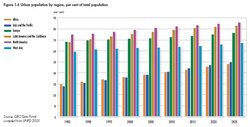
Urbanization continues around the world, particularly in developing countries, where rural migration continues to fuel urban growth (see Figure 1.6). By the end of 2007, more people will be living in cities than in rural areas for the first time in history [100]. In North East Asia and South East Asia, the population living in urban areas increased from 28–29 per cent in 1985 to 44 per cent in 2005, and is projected to reach 59 per cent by 2025 [101]. In some places, the urban area is increasing faster than the urban population, a process known as urban sprawl. For example, between 1970 and 1990, the total area of the 100 largest urban areas in the United States increased by 82 per cent. Only half of this increase was caused by population growth [102] (see Box 1.9). A growing number of people living in urban areas are living in slums – inadequate housing with no or few basic services [103]. In many sub-Saharan African cities, children living in slums are more likely to die from water-borne and respiratory illnesses than rural children. For 2005, the number of slum dwellers was estimated at almost 1 billion [104].
Migration and urbanization have complex relationships with environmental change. Natural disasters, and degradation of land and local ecosystems are among the causes of migration [105]. Changing demographic patterns, caused by migration or urbanization, alter land use and demand for ecosystem services (see Box 1.9).
|
Box 1.9 Urban sprawl, Las Vegas[106] |
|
Las Vegas, the fastest growing metropolitan area in the United States, exemplifies the problems of rampant urban sprawl. As the gaming and tourism industry blossomed, so has the city’s population. In 1985, Las Vegas was home to 557,000 people, and was the 66th largest metropolitan area in the United States. In 2004, the Las Vegas-Paradise area was ranked 32nd in size, with a permanent population nearing 1.7 million. According to one estimate, it may double by 2015. Population growth has put a strain on water supplies. Satellite imagery of Las Vegas provides a dramatic illustration of the spatial patterns and rates of change resulting from the city’s urban sprawl. The city covers the mainly green and grey areas in the centre of these images recorded in 1973 and 2000. Note the proliferation of roads and other infrastructure (the rectangular pattern of black lines) and the dramatic increase in irrigated areas. 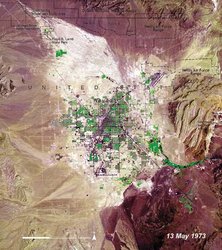 Credit: UNEP 2005b[107] 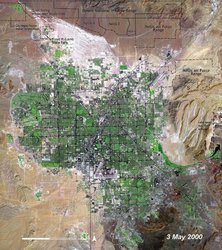 Credit: UNEP 2005b[108] |
Urbanization in particular can exert significant pressure on the environment (see [[Chapter 6 (Global Environment Outlook (GEO-4): Chapter 1)]4]). Coastal urban areas often cause offshore water pollution. Coastal populations alone are expected to reach 6 billion by 2025 [109]. In these areas, large-scale development results in excessive nutrient inputs from municipal and industrial waste. As described in [[Chapter 4 (Global Environment Outlook (GEO-4): Chapter 1)]3], eutrophication contributes to the creation of dead zones, areas of water with low or no dissolved oxygen. Fish cannot survive, and aquatic ecosystems are destroyed. Dead zones are an emerging problem in Asia, Africa and South America, but are present around the world. With population growth, and increasing industrialization and urbanization, dead zones can only continue to expand. Properly managed, cities can also become a solution for some of the environmental pressures. They provide economies of scale, opportunities for sustainable transport and efficient energy options.
Economic growth
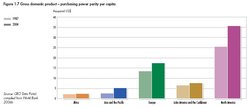
Global economic growth has been spectacular during the last two decades. Gross domestic product per capita (at purchasing power parity) increased by almost 1.7 per cent annually, but this growth was unevenly spread (see Figure 1.7). People in Africa, Eastern Europe and Central Asia, and certain areas of Latin America and the Caribbean are worse off than those in North America and Central and Western Europe. Many countries in these regions experienced no growth and some even a clear economic decline between 1987 and 2004. Especially in Africa there are large differences within the region, and even where there is growth, countries are faced with a heavy debt burden (see Box 1.10). Income in Asia and the Pacific is still well below the global average, but its growth rate was twice the global average. These sub-regional differences are highlighted in [[Chapter 6 (Global Environment Outlook (GEO-4): Chapter 1)]5].
Economic growth and unsustainable consumption (Consumer society) patterns represent a growing pressure on the environment, though this pressure is often distributed unequally. Dasgupta [111] argues that economic growth is unsustainable in poor countries, partly because it is sustainable in wealthy countries. Countries that export resources are subsidizing the consumption of importing countries [112]. However, consumption patterns among regions are changing with the emergence of new economies and powers such as China, India, Brazil, South Africa and Mexico. China, for example, is expected to become the world’s largest economy between 2025 and 2035. Its rapid economic development is influencing global patterns of resource production and consumption, with both environmental and geopolitical consequences [113]. Vehicle ownership patterns illustrate the impact of changing consumption patterns (see [[Chapter 2 (Global Environment Outlook (GEO-4): Chapter 1)]4]). China had some 27.5 million passenger vehicles and 79 million motorcycles in use by 2004 [114]. The growing trend in vehicle ownership affects urban air quality, which has clear consequences for human health.
|
Box 1.10 Debt repayments continue to be a major impediment to growth[115] | |
|
Even though Africa has only 5 per cent of the developing world’s income, it carries about two-thirds of the Global South’s debt burden – over US$300 billion. Despite extreme poverty, sub-Saharan Africa transfers US$14.5 billion a year to rich nations in external debt repayments. The average sub-Saharan African country, therefore, spends three times more on repaying debt than it does on providing basic services to its people. By the end of 2004, Africa spent about 70 per cent of its export earnings on external debt servicing. At the 2005 Gleneagles Summit, G8 countries cancelled 100 per cent of debts of a number of eligible Heavily Indebted Poor Countries to three multilateral institutions – the International Monetary Fund (IMF), International Development Association (IDA) and African Development Fund. This was a step towards relieving the burden that debt repayment places on growth and social services. As a result of debt cancellation and targeted aid increases between 2000 and 2004, 20 million more children in Africa are in school. While G8 countries reaffirmed Gleneagles commitments at the 2007 Heiligendamm Summit, their ability to fulfill these promises has been questioned. |
Globalization
The world’s economy has been characterized by growing globalization, which is spurring the increasing integration of the global economy through trade and financial flows, and in the integration of knowledge through the transfer of information, culture and technology [116]. Governance has also become globalized, with increasingly complex interstate interactions, and with a growing role for non-state actors. International companies have become influential economic actors in a global governance context traditionally dominated by nations. While states “rule the world,” corporations have publicly sought the global political stage at gatherings such as the World Economic Forum and at multilateral negotiations, such as the Multilateral Agreement on Investment [117]. Advances in technology and communications, such as the Internet, have also boosted the role of individuals and organizations as key players in a globalized world [118].
Globalization raises both fears and expectations. Some suggest that increasing interdependence is good for cooperation, peace and solving common problems [119]. Economic integration may offer dynamic benefits, such as higher productivity. The exchange of goods-and-services also helps the exchange of ideas and knowledge. A relatively open economy is better able to learn and adopt foreign, state-of-the-art technologies than is a relatively closed economy [120]. Others, however, view growing economic interdependence as destabilizing. They say that rapid flows of investment into and out of countries cause job losses, increase inequality, lower wages [121] and result in harm to the environment. It is argued that globalization is exploitative, and is creating a murkier future for global cooperation and justice [122].
The environment and globalization are intrinsically linked. The globalization of trade has facilitated the spread of exotic species, including the five most important freshwater suspension feeding invaders (Dressena polymorpha, D. bugensis, Corbicula fluminea, C. fluminalis and Limoperna fortunei). The zebra mussel (Dressena polymorpha) has spread through North America during the last 20 years, resulting in significant ecological and economic impacts. Its introduction corresponds with dramatic increase in wheat shipments between the US, Canada and the former Soviet Union [123]. In a globalized world, important decisions related to environmental protection may have more to do with corporate management and market outcomes than with state-level, political factors. Countries may be reluctant to enforce strict environmental laws, fearing that companies would relocate elsewhere. However, it is often forgotten that the environment itself can have an impact on globalization. Resources fuel global economic growth and trade. Solutions to environmental crises, such as climate change, require coordinated global action and greater globalization of governance [124].
Trade
World trade has continued to grow over the past 20 years, as a result of lower transport and communication costs, trade liberalization and multilateral trade agreements, such as the North American Free Trade Agreement. Between 1990 and 2003, trade in goods increased from 32.5 to 41.5 per cent of world GDP. Differences exist between regions. In North East Asia, trade in goods increased from 47 to 70.5 per cent of GDP, and high technology exports increased from 16 to 33 per cent of manufactured exports. By contrast, trade in goods in West Asia and Northern Africa only increased from 46.6 per cent to 50.4 per cent of GDP. High technology exports only accounted for 2 per cent of manufactured exports in 2002 [125]. Since 1990, least developed countries (LDC) have increased their share of world merchandise trade, but still accounted for only 0.6 per cent of world exports and 0.8 per cent of world imports in 2004 [126].
|
Box 1.11 Trade, growth and the environment[127] |
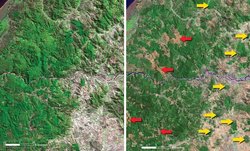 Credit: UNEP 2005b[128] In recent years, Chile has been considered one of the most economically competitive countries in Latin America and the Caribbean. Rapid growth in Chile’s production and export of forest products is based on the expansion and management of exotic species in newly planted forests over the past 30 years. To do so, the traditional land-use practices in small-scale logging of native forests, livestock raising and [[agricultural] cultivation] have been replaced by large-scale timber production. Many endangered tree and shrub species have been affected by this growth of planted forest, which has also led to a dramatic reduction of landscape diversity as well as goods-and-services from forests. The two images, taken in 1975 (left) and 2001 (right), show clear reductions in forested land on the one hand (red arrows), and new forest areas on the other (yellow arrows). |
As with globalization, a two-way relationship exists between the environment and trade. Transport has increased as a result of increasing flows of goods and global production networks. Transport is now one of the most dynamic sectors in a modern economy, and has strong environmental impacts [129] (see Chapters 2 and 6 (Global Environment Outlook (GEO-4): Chapter 1)). Trade itself can exert pressures on the environment. Increases in international grain prices may increase the profitability of agriculture, and result in the expansion of farming into forested areas in Latin America and the Caribbean, for example (see Box 1.11). The wildlife trade in Mongolia, valued at US$100 million annually, is contributing to the rapid decline of species such as saiga antelope [130]. In the presence of market or intervention failures, international trade may also exacerbate environmental problems indirectly. For example, production subsidies in the fishing sector can promote overfishing [131]. Natural disasters, in turn, can have an impact on trade at the national level, when exports fall as a result of physical damage. One example of this linkage is the hurricane damage to oil refineries in the Gulf of Mexico in 2005. Oil production in the Gulf of Mexico, which supplies 2 per cent of the world’s crude oil, slowed following Hurricane Katrina, and crude oil prices jumped to over US$70 a barrel [132].
Trade may also be positive for the environment. Debate rages over whether or not free trade will raise incomes to a point where environmental protection becomes a priority [133]. At the 2002 WSSD in Johannesburg, commitments were made to expand [[market]s] for environmental goods-and-services. Liberalization of trade in goods that protect the environment may help spur the creation of industry dedicated to environmental improvements [134]. Consumer preferences can influence production standards, which can be used to improve environmental conditions. In 2006, a large grain distributor imposed a moratorium on the purchase of soy produced on deforested areas of the Amazon, as a result of a Greenpeace campaign in Europe [135].
Energy
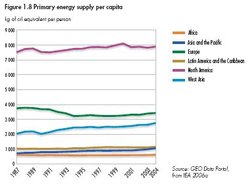
The world is facing twin threats: inadequate and insecure supplies of energy at affordable prices, and environmental damage due to overconsumption of energy [137]. Global demand for energy keeps growing, placing an ever-increasing burden on natural resources and the environment. For about three decades, world primary energy demand grew by 2.1 per cent annually, rising from 5 566 million tonnes oil equivalent (Mtoe) in 1971 to 11 204 Mtoe in 2004 [138]. Over two-thirds of this increase came from developing countries, but OECD countries still account for almost 50 per cent of world energy demand. In 2004, primary energy use per capita in OECD countries was still 10 times higher than in sub-Saharan Africa. Figure 1.8 highlights primary energy supply per capita.
Global increases in carbon dioxide emissions are primarily due to fossil fuel use [139], the fuels that met 82 per cent of the world’s energy demand in 2004. Traditional biomass (firewood and dung) remains an important energy source in developing countries, where 2.1 billion people rely on it for heating and cooking [140]. Use of cleaner energy sources, such as solar and wind power, remains minimal overall (see Figure 5.5, [[Chapter 5 (Global Environment Outlook (GEO-4): Chapter 1)]3] for energy supply by source). The need to curb growth in energy demand, increase fuel supply diversity and mitigate climate destabilizing emissions is more urgent than ever [141]. However, expansion of alternative energy sources, such as biofuels, must also be carefully planned. Brazil expects to double the production of ethanol, a “modern” biofuel, in the next two decades [142]. In order to produce enough crops to reach production targets, the cultivated area is increasing rapidly. The growth of farming jeopardizes entire ecoregions, like the Cerrado, one of the world’s biodiversity hot spots [143].
Technological innovation
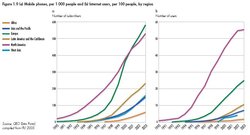
Advances in agriculture, energy, medicine and manufacturing have offered hope for continued human development and a cleaner environment. New farming technologies and practices related to water use, fertilizer and plant breeding have transformed agriculture, increasing food production and addressing undernutrition and chronic famine in some regions. Since 1970, food consumption is increasing in all regions, and is expected to continue to increase as a result of economic development and population (Human population explosion) growth. Concerns have been raised over the ability to meet future demand: 11 per cent of the world’s land is already used for agriculture, and in many places little room exists for agricultural expansion due to land or water shortages. Biotechnology, including genetic modification, as well as nanotechnology, has the potential to increase production in agriculture and contribute to advances human health [145], but remains subject to much controversy over effects on health and the environment. Earlier lessons from new technologies show the importance of applying the precautionary approach [146], because unintended effects of technological advances can lead to the degradation of ecosystem services. For example, eutrophication of freshwater systems and hypoxia in coastal marine ecosystems result from excess application of inorganic fertilizers. Advances in fishing technologies have contributed significantly to the depletion of marine fish stocks.
Communications and cultural patterns have also been revolutionized in the last 20 years, with the exponential growth of the Internet and telecommunications (see Figure 1.9). Worldwide, mobile phone subscribers increased from 2 per 1,000 people in 1990 to 220 per 1,000 in 2003 and worldwide Internet use increased from 1 in 1,000 in 1990 to 114 per 1,000 in 2003 [147]. Many developed countries lead the way in the number of Internet users, hosts and secure servers, prompting some to claim that there is a digital divide between different regions of the world. In Australia and New Zealand, for example, only 4 per cent of the population used Internet in 1996, but by 2003, that had risen to 56 per cent of the population By contrast in 2003, in poor countries such as Bangladesh, Burundi, Ethiopia, Myanmar and Tajikistan only 1 or 2 people per 1 000 used the Internet [148].
Governance
The global and regional political context has changed considerably since the Brundtland Commission, with the end of the Cold War triggering renewed optimism in multilateral and global governance. The 1990s was a decade of global summits on a diversity of issues, including children (1990), sustainable development (1992), human rights (1994), population (1994), social development (1995), gender equality (1995) and human settlements (1996). The new millennium has been equally active and agenda-setting, starting with the Millennium Summit in 2000, and its follow-up in 2005. Normative declarations and ambitious action plans from all these summits illustrate an emerging unity in how governments and the international community understand complex and global problems and formulate appropriate responses. The establishment of the World Trade Organization in 1994 strengthened global governance through its considerable authority in the areas of trade, while the establishment of the International Criminal Court of Justice in 2002 attempted to do the same for crimes against humanity. Some important reforms have happened within the UN system, including an approach that increasingly uses partnerships (such as the Global Water Partnership) and institutionalized processes to strengthen the participation of civil society (such as the UNEP’s Global Civil Society Forum and Global Women’s Assembly on Environment).
At the regional level, countries have expanded or established institutions to enhance cooperation, including the European Union (EU), the [[North American Free Trade Agreement] (NAFTA)], the Southern Common Market (MERCOSUR), the Association of Southeast Asian Nations (ASEAN) and the African Union (AU). Regions became more visible in global deliberations, through, for example, the emphasis on regional preparation meetings for the World Summit on Sustainable Development.
The national level remains central in governance, despite discussions in the context of globalization and regionalization. Some countries are adopting innovative governance systems and there has been a trend towards both political and fiscal decentralization of governance to sub-national levels. This does not necessarily mean that local authorities have been empowered. It has been argued that decentralization without devolution of power can be a way to strengthen the presence of the central authority [149]. Local governments have also engaged much more widely in international cooperation in various arenas, and their role has been strengthened at the global level through the establishment in 2000 of the UN Advisory Committee of Local Authorities (UNACLA) and the World Urban Forum in 2002, as well as the founding of the United Cities and Local Governments Organization in 2004.
Responses
Interactions between drivers and pressures, and their consequent impacts on ecosystem services and human well-being present challenges that could not be foreseen in 1987. There is an urgent need for effective policy responses at all levels – international, regional, national and local. As highlighted in the other chapters of this report, the range and scope of response options available to policy-makers has progressively evolved over the past 20 years (see Box 1.12), with a diversity of multilateral environmental agreements and institutions now involved in trying to address the challenges. The increase in governance regimes has brought about its own challenges, including competition and overlap. An interlinkages approach is essential to managing the environment, not in its individual parts but more holistically. This approach recognizes that the environment itself is interlinked; land, water and atmosphere (Atmospheric composition and structure) are connected in many ways, particularly through the carbon (Carbon cycle), nitrogen (Nitrogen cycle) and water cycles. Chapter 8 (Global Environment Outlook (GEO-4): Chapter 1) highlights both the biophysical and governance regimes interlinkages.
|
Box 1.12 Types of responses |
|
Command-and-control regulation includes standards, bans, permits and quotas, zoning, liability systems, legal redress, and flexible regulation. Direct provisions by government deal with environmental infrastructure, eco-industrial zones or parks, protected areas and recreation facilities, and ecosystem rehabilitation. Public and private sector engagement relates to public participation, decentralization, information disclosure, eco-labelling, voluntary agreements and public-private partnerships. Market use includes environmental taxes and charges, user charges, deposit-refund systems, targeted subsidies, and the removal of perverse subsidies (Subsidies and market interventions). Market creation addresses issues of property rights, tradeable permits and rights, offset programmes, green programmes, environmental investment funds, seed funds and incentives. |
[[Chapter 10 (Global Environment Outlook (GEO-4): Chapter 1)]2] highlights the evolution of policy response measures – from a focus on command-and-control policies to creating [[market]s] and incentives, particularly for industry to implement voluntary measures aimed at minimizing environmental damage. For conventional, well-known environmental problems with proven solutions, it is necessary to continue to apply, and to further improve upon previously successful approaches. Countries that have yet to address such problems should apply these proven, workable solutions to current problems. Previously successful approaches have generally addressed changes to pressures, for example by regulating emission levels, land use or resource extraction. In order to address less-known persistent (or emerging) problems, transformative policies are needed. These policies address the drivers of environmental problems, such as demographic change and consumption (Consumption and well-being) patterns. Adaptive management is essential, to enable policymakers to learn from previous experience as well as to make use of a variety of new tools that may be needed.
Economic instruments
Today, greater emphasis is being placed on the potential use of economic instruments to help correct market failures. These instruments were promoted by Principle 16 of the Rio Declaration: “National authorities should endeavour to promote the internalization of environmental costs and the use of economic instruments.”
Natural resources can be seen as a capital (Natural capital) asset belonging to a general portfolio, which is comprised of other assets and [[capital]s], including material, financial, human and social. Managing this portfolio in a good and sustainable manner to maximize its returns and benefits over time is good investment. It is also central to sustainable development.
A variety of economic instruments exist, including property rights, market creation, fiscal instruments, charge systems, financial instruments, liability systems, and bonds and deposits. There is a mix of so-called market-based instruments (MBIs) and command-and-control instruments to enable policymakers to better manage and get more accurate information regarding the portfolio of capital assets. Table 1.2 summarizes different economic instruments, and how they can be applied to different environmental sectors. One of the tools is valuation, which can be used to help better assess the value of ecosystem services, and the costs of human-induced changes to the environment.
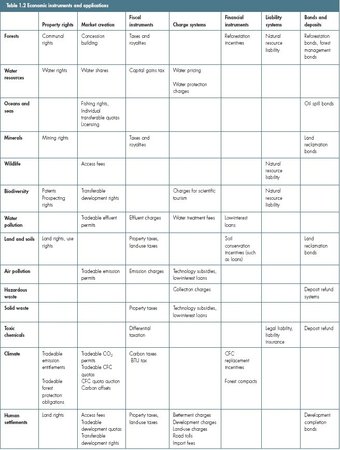

Valuation
Environmental ministries and agencies are often the last to benefit from investments, because economics and growth generation take precedence in government spending decisions. This is often due to lack of information on the value and carrying limits of the Earth’s ecosystems. Measurement of economic development and progress has often been linked to measures of economic output such as Gross National Product (GNP). Such aggregate measurements do not consider the depletion of natural capital caused by the consumption and production of goods-and-services. National accounting systems need revision to better include the value of the changes in the environmental resource base due to human activities [152].
Valuing different goods-and-services involves comparisons across different sets of things. How these things are accounted for, and how the services provided by the ecosystems, for example, improve well-being is called the accounting price. Table 1.3 illustrates different approaches to valuation, and how these approaches might be used to help assess the impact of policies on environmental change and human well-being.
A “set of institutions capable of managing the natural resources, legal frameworks, collecting resource rents, redirecting these rents into profitable investments” is key to effective use of valuation [153]. Valuing natural resources and evaluating policies where institutions such as [[market]s] do not exist, and where there is a lack of individual property rights, pose challenges. Under such uncertainties, and where divergent sets of values exist, the economic value of common resources can be measured by the maximum amount of other goods-and-services that individuals are willing to give up to obtain a given good or service. Therefore, it is possible to weigh the benefits from an activity such as the construction of a dam against its negative impacts on fishing, livelihoods of nearby communities, and changes to scenic and aesthetic values. Box 1.13 provides an example of non-market valuation using the contingent valuation method (CVM).
Valuation presents a set of challenges beyond conflicting value systems or lack of existing market institutions. It uses notional and proxy measures to estimate the economic values of tangible and intangible services provided by the environment. An increasing body of valuation work has been undertaken on provisioning services of ecosystems. It has produced estimates of the value of non-timber forest products, forestry, and the health impacts of air pollution and water-borne diseases. However, studies on less tangible but yet important services, such as water purification and the prevention of natural disasters, as well as recreational, aesthetic and cultural services, have been hard to get. To get objective monetary estimates of these services remains a challenge. Market data is limited to a small number of services provided by ecosystems. Furthermore, methodologies such as cost-benefit analysis and CVM may raise problems of bias.
|
Box 1.13 Valuing the removal of the Elwha and Glines Dams[154] |
|
An environmental impact analysis using CVM was conducted in the 1990s to explore the removal of the Elwha and Glines dams in Washington State in the United States. These two 30- and 60-metre-high dams, respectively, are old, and block the migration of fish to 110 km of pristine water located in the Olympic National Park. The dams also harm the Lower Elwha Klallam Tribe which relies on the salmon and river for their physical, spiritual and cultural well-being. Dam removal could bring substantial fishing benefits, more than tripling the salmon populations. The cost of removing the dams, and especially the sediment build-up is estimated at about US$100–$125 million. Recreational and commercial fishing benefits resulting from dam removal would not be sufficient to cover these costs. A CVM survey was conducted and yielded a 68 per cent response in Washington State, and 55 per cent response for the rest of the United States. Willingness to pay for dam removal ranged from US$73 per household for Washington to US$68 for the rest of the United States. If every household in Washington State were to pay US$73, the cost of dam removal and river restoration could be covered. If the return stemming from Washington residents’ willingness to pay was added to the rest of the US willingness to pay (the 86 million households and their willingness to pay an average of US$68 per head) in excess of US$1 billion dollars would result. After years of negotiations it has been decided that the dams will be removed, and the Elwha Restoration Project will go forward. This is the biggest dam-removal project in history, and an event of national significance in the United States. It is expected that the two dams will be removed in stages over the course of three years, between 2009 and 2011. |
The use of market and non-market-based instruments has also shown gaps in addressing distributional and intergenerational equity issues [155], notably with regard to poverty-related issues. Finally, many valuation studies estimating the impact of policies or projects on human well-being fail due to the lack of sufficiently precise estimates of the consequences of these policies or projects now and in the future. Despite these flaws, valuation may be a useful tool with which to examine the complex relationships and feedback involving the environment, economic growth and human well-being.
Non-economic instruments
In addition to economic instruments, a variety of noneconomic instruments have been employed to address both well-known proven and less clear emerging (or persistent) environmental problems. Today, the emerging understanding of human well-being increasingly influences our choice of instruments.
Public participation
Human well-being depends on the unconstrained ability of people to participate in decisions, so that they can organize society in a way that is consistent with their highest values and aspirations. In other words, public participation is not only a matter of procedural justice, but also a precondition for achieving well-being. While this is challenging, managers should involve civil society in policy interventions. The Convention on Biological Diversity offers several examples of possible stakeholder engagement in decision making. These include CBD VII/12, The Addis Ababa Guidelines on the sustainable use of the components of biodiversity; CBD VII/14 guidelines on sustainable tourism development; and the CBD VII/16 Akwe, on voluntary guidelines for the conduct of cultural, environmental and social impact assessments for development proposals on sacred sites, lands and waters traditionally occupied or used by indigenous and local communities. The development of similar agreements and protocols that enhance effective engagement of all sectors of society should be encouraged.
Education
Access to information and education is a basic human right, and an important aspect of human well-being. It is also an important tool for generating knowledge that links ecological analyses to societal challenges, and is critical to the decision making process. Women and marginalized communities must be ensured access to education. The United Nations launched its Decade of Education for Sustainable Development (DESD) in 2005 and designated UNESCO as lead agency for the promotion of the Decade (see Box 1.14).
Justice and ethics
Since the environment affects the very basis of human well-being, it is a matter of justice to consider the impacts of environmental degradation on others, and attempt to minimize harm for both current and future generations. It has been argued that a “global ethic” is required to address the problems of the 21st century [156]. The intrinsic value of species has also been recognized[157]. The pursuit of some people’s opportunities and freedoms may harm or limit those of others. It is important that policymakers consider the adverse effects their decisions have on people and the environment in other areas or regions, since such communities do not participate in local decision making.
|
Box 1.14 The UN Decade of Education for Sustainable Development[158] |
|
The overall goal of the DESD is “to integrate the principles, values, and practices of sustainable development into all aspects of education and learning.” This educational effort will encourage changes in behaviour that will create a more sustainable future in terms of environmental integrity, economic viability, and a just society for present and future generations. In the long-term, education must contribute to government capacity building, so that scientific expertise can inform policy. |
Scenario development
The use of scenarios to inform policy processes is growing, providing policy-makers with opportunities to explore the likely impacts and outcomes of various policy decisions. The goal of developing scenarios “is often to support more informed and rational decision making that takes both the known and unknown into account”[159]. Their purpose is to widen perspectives and illuminate key issues that might otherwise be missed or dismissed. Chapter 9 (Global Environment Outlook (GEO-4): Chapter 1) uses four plausible scenarios to explore the impact of different policy decisions on environmental change and future human well-being.
Conclusion
Two decades after Our Common Future emphasized the urgency of sustainable development, environmental degradation continues to threaten human well-being, endangering health, physical security, social cohesion and the ability to meet material needs. Analyses throughout GEO-4 also highlight rapidly disappearing forests, deteriorating landscapes, polluted waters and urban sprawl. The objective is not to present a dark and gloomy scenario, but an urgent call for action.
While progress towards sustainable development has been made through meetings, agreements and changes in environmental governance, real change has been slow. Since 1987, changes to drivers, such as population growth, consumption (Consumption and well-being) patterns and energy use, have placed increasing pressure on the state of the environment. To effectively address environmental problems, policy-makers should design policies that tackle both pressures and the drivers behind them. Economic instruments such as market creation and charge systems may be used to help spur environmentally sustainable behaviour. Valuation can help policy-makers make informed decisions about the value of changes to ecosystem services. Noneconomic instruments should be used to address both well-known problems with proven solutions and less clear emerging problems. This chapter has provided an overview of the challenges of the 21st century, highlighted conceptual ideas that have emerged to analyse and understand these environmental problems, and indicated options on the way forward.
The following chapters highlight areas where society has contributed to environmental degradation and human vulnerability. Everyone depends on the environment. It is the foundation of all development, and provides opportunities for people and society as a whole to achieve their hopes and aspirations. Current environmental degradation undermines natural assets, and negatively affects human well-being. It is clear that a deteriorating environment is an injustice to both current and future generations.
The chapters also emphasize that alternative development paths that protect the environment are available. Human ingenuity, resilience and capacity to adapt are powerful forces from which to draw to effect change.
Imagine a world in which human well-being for all is secure. Every individual has access to clean air and water, ensuring improvements in global health. Global warming has been addressed, through reductions in energy use, and investment in clean technology. Assistance is offered to vulnerable communities. Species flourish as ecosystem integrity is assured.
Transforming these images into reality is possible, and it is this generation’s responsibility to start doing so.
Contributors
Coordinating lead authors: Diego Martino and Zinta Zommers Lead authors: Kerry Bowman, Don Brown, Flavio Comim, Peter Kouwenhoven, Ton Manders, Patrick Milimo, Jennifer Mohamed-Katerere, and Thierry De Oliveira Contributing authors: Dan Claasen, Simon Dalby, Irene Dankelman, Shawn Donaldson, Nancy Doubleday, Robert Fincham, Wame Hambira, Sylvia I. Karlsson, David MacDonald, Lars Mortensen, Renata Rubian, Guido Schmidt-Traub, Mahendra Shah, Ben Sonneveld, Indra de Soysa, Rami Zurayk, M.A. Keyzer, and W.C.M. Van Veen Chapter review editor: Tony Prato Chapter coordinators: Thierry De Oliveira, Tessa Goverse, and Ashbindu Singh (Global Environment Outlook (GEO-4): Chapter 1)
Notes ^MA (2005c). Ecosystems and Human Well-being: Volume 2 – Scenarios. Millennium Ecosystem Assessment. Island Press, Washington, DC. This is a chapter from Global Environment Outlook (GEO-4): Environment for Development (e-book). Previous: Reader's Guide|Table of Contents (Global Environment Outlook (GEO-4): Chapter 1) |Next: Chapter 2 (Global Environment Outlook (GEO-4): Chapter 1) 5
</div>Citation
Programme, U. (2012). Global Environment Outlook (GEO-4): Chapter 1. Retrieved from http://editors.eol.org/eoearth/wiki/Global_Environment_Outlook_(GEO-4):_Chapter_1
- ↑ IUCN, UNEP and WWF (1991). Caring for the Earth: A Strategy for Sustainable Living. The World Conservation Union, United Nations Environment Programme and World Wide Fund for Nature, Gland.
- ↑ Langhelle, O. (1999). Sustainable development: exploring the ethics of Our Common Future. In International Political Science Review 20 (2):129-149.
- ↑ WCED (1987). Our Common Future. Oxford University Press, Oxford.
- ↑ UNEP (2002). Global Environment Outlook (GEO-3). United Nations Environment Programme, Nairobi.
- ↑ GEF (2006). What is the GEF? The Global Environment Facility, Washington, DC (last accessed 1 May 2007).
- ↑ UN (2000). United Nations Millennium Declaration. United Nations, New York, NY (last accessed 1 May 2007).
- ↑ UN (2002). Report of the World Summit on Sustainable Development. Johannesburg, South Africa, 26 August - 4 September. A/CONF.199/20. United Nations, New York, NY.
- ↑ GEO Data Portal. UNEP’s online core database with national, sub-regional, regional and global statistics and maps, covering environmental and socio-economic data and indicators. United Nations Environment Programme, Geneva (1 or <a href="http://geodata.grid.unep.ch" rel="nofollow" title="http://geodata.grid.unep.ch">2</a>, last accessed 12 June 2007), compiled from various MEA secretariats.
- ↑ UNGA 1992.
- ↑ UN (2002). Report of the World Summit on Sustainable Development. Johannesburg, South Africa, 26 August - 4 September. A/CONF.199/20. United Nations, New York, NY.
- ↑ Carothers, T. and Barndt, W. (2000). Civil Society. In Foreign Policy (11):18-29 China Statistical Bureau (1987-2004).
- ↑ WBCSD (2007). Then & Now: Celebrating the 20th Anniversary of the “Brundtland Report” – 2006 WBCSD Annual Review. World Business Council for Sustainable Development, Geneva.
- ↑ Prakash, A. (2000). Responsible Care: An Assessment. In Business and Society 39(2):183-209.
- ↑ WBCSD (2007). Then & Now: Celebrating the 20th Anniversary of the “Brundtland Report” – 2006 WBCSD Annual Review. World Business Council for Sustainable Development, Geneva.
- ↑ Bass, S. (2006). Making poverty reduction irreversible: development implications of the Millennium Ecosystem Assessment. IIED Environment for the MDGs’ Briefing Paper. International Institute on Environment and Development, London.—World Bank (2006a). Where is the Wealth of Nations? Measuring Capital for the 21st Century. The World Bank, Washington, DC.
- ↑ UNDP (2006) Human Development Report 2006. Beyond Scarcity: power, poverty and the global water crisis. United Nations Development Programme, New York, NY.
- ↑ UNDP (2005a). Environmental Sustainability in 100 Millennium Development Goal Country Report. United Nations Development Programme, New York, NY.
- ↑ Adapted from DFID and others 2002.—UNDP (2006) Human Development Report 2006. Beyond Scarcity: power, poverty and the global water crisis. United Nations Development Programme, New York, NY.—UNICEF (2006). Pneumonia: The forgotten killer of children. United Nations Childrens Fund and World Health Organization, New York, NY.
- ↑ Rahnema, M. (Ed.) (1997). The Post-Development Reader. Zed Books, London.
- ↑ Shiva, V. (1991). The Violence of the Green Revolution: Third World Agriculture, Ecology and Politics. Zed Books, London.
- ↑ Dernbach, J. (2002). Stumbling Toward Sustainability. Environmental Law Institute, Washington, DC.
- ↑ Travis 2005.—Fischetti, M. (2005). Protecting against the next Katrina: Wetlands mitigate flooding, but are they too damaged in the gulf? In Scientific American October 24.
- ↑ Gore, A. (2006). An Inconvenient Truth: the planetary emergency of global warming and what we can do about it. Bloomsbury, London.
- ↑ Brown, D. (1999). Making CSD Work. In Earth Negotiations Bulletin 3(2):2-6.
- ↑ MacDonald, D. and Service, K (2007). Key Topics in Conservation Biology. Blackwell Publications, Oxford.
- ↑ Speth, J. (2004). Red Sky at Morning: America and the Crisis of the Global Environment. Yale University Press, New Haven and London.
- ↑ Jänicke, M. and Volkery, A. (2001). Persistente Probleme des Umweltschutzes. In Natur und Kultur 2(2001):45-5.
- ↑ Solow, R. M. (1991), Sustainability: An Economist’s Perspective. The Eighteen J. Seward Johnson Lecture to the Marine Policy Center, Woods Hole Oceanographic Insitution. In Economics of the Environment: Selected Readings (ed. R. Dorfman and N.s Dorfman) 179-187. Norton, New York, NY.
- ↑ Diener, E. (2000). Subjective well-being. The science of happiness and a proposal for a national index. In The American Psychologist 55:34-43.—Frey, B and Stutzer, A. (2005). Beyond Outcomes: Measuring Procedual Utility. In Oxford Economic Papers 57(1):90-111.
- ↑ Sen, A. (1985). Commodities and Capabilities, Oxford University Press, Oxford.—Sen, A. (1992). Inequality Re-examined. Clarendon Press, Oxford.—Sen, A. (1999). Development as Freedom. Oxford University Press, Oxford.
- ↑ MA (2003). Ecosystems and Human Well-being; a framework for assessment. Millennium Ecosystem Assessment. Island Press, Washington, DC.—Sen, A. (1999). Development as Freedom. Oxford University Press, Oxford.
- ↑ UN (2004). Human Rights and Poverty Reduction. A conceptual framework. United Nations Office of the High Commissioner for Human Rights. United Nations, New York and Geneva.
- ↑ UNDP (2005b) Human Development Report 2005: International Cooperation at a Crossroads. United Nations Development Programme, New York, NY.
- ↑ Braidotti, R., Charkiewicz, E., Hausler, S. and Wieringa, S. (1994). Women, the Environment and Sustainable Development. Zed, London.
- ↑ Agarwal, B. (2000). Conceptualizing Environmental Collective Action: Why Gender Matters. In Cambridge Journal of Economics 24(3):283-310.
- ↑ Cleaver, F. (2000). Analysing Gender Roles in Community Natural Resource Management: Negotiation, Life Courses, and Social Inclusion. In IDS Bulletin 31(2):60-67.
- ↑ MA (2003). Ecosystems and Human Well-being; a framework for assessment. Millennium Ecosystem Assessment. Island Press, Washington, DC.
- ↑ MA (2005c). Ecosystems and Human Well-being: Volume 2 – Scenarios. Millennium Ecosystem Assessment. Island Press, Washington, DC.
- ↑ WRI (2005). World Resources 2005: The Wealth of the Poor – Managing Ecosystems to Fight Poverty. World Resources Institute in collaboration with the United Nations Development Programme, the United Nations Environment Programme and The World Bank. World Resources Institute, Washington, DC.
- ↑ MA (2003). Ecosystems and Human Well-being; a framework for assessment. Millennium Ecosystem Assessment. Island Press, Washington, DC.
- ↑ WHO (2006). Preventing disease through healthy environments: Towards an estimate of the environmental burden of disease. World Health Organization, Geneva.
- ↑ WHO (2000). Guidelines for Air Quality. WHO/SDE/OEH/00.02, World Health Organization, Geneva.
- ↑ WHO (2002) The World Health Report. Reducing risks, promoting healthy life. World Health Organization, Geneva.
- ↑ Bell, D., Robertson, S. and Hunter, P. (2004). Animal origins of SARS coronavirus: possible links with the international trade of small carnivores. In Philosophical Transactions of the Royal Society London 359:1107-1114.—Brown, S. (2006). The west develops a taste for bushmeat. In New Scientist 2559:8—Goodall, J. (2005). Introduction. In Reynolds, V. (ed.). The Chimpanzees of the Budongo Forest. Oxford University Press, Oxford.—Fa, J., Albrechtsen, L. and Brown. D. (2007). Bushmeat: the challenge of balancing human and wildlife needs in African moist tropical forests. In Macdonald, D. and Service, K. (eds.) Key Topics in Conservation Biology 206-221. Blackwell Publishing, Oxford.—Karesh, W., Cook, R., Bennett, E. and Newcomb, J. (2005). Wildlife Trade and Global Disease Emergence. In Emerging Infectious Diseases 11 (7):1000-1002.—LeRoy, E., Rouquet, P., Formenty, P., Souquière, S., Kilbourne, A., Froment, J., Bermejo, M., Smit, S., Karesh, W., Swanepoel, R., Zaki, S. and Rollin, P. (2004). Multiple Ebola virus transmission events and rapid decline of central African wildlife. In Science 303:387-390.—Li, W., Shi, Z., Yu, M., Ren, W., Smith, C., Epstein, J. Wang, H. Crameri, G., Hu., Z., Zhang, H., Zhang, J., McEachern, J., Field, H., Daszak, P., Eaton, B., Zhang, S. and Wang, L. (2005). Bats are natural reservoirs of SARS-like coronavirsues. In Science 310:676-679.—Peiris, J., Guan, Y. and Yuen, K. (2004). Severe acute respiratory syndrome. In Nature Medicine 10 (12):S88- S97.—Peterson, D. (2003). Eating Apes. University of California Press, London.—Wolfe, N., Switzer. W., Carr, J., Bhullar, V., Shanmugam, V., Tamoufe, U., Prosser, A., Torimiro, J., Wright, A., Mpoudi-Ngole, E., McCutchan, F., Birx. D., Folks, T., Burke, D. and Heneine, W. (2004). Naturally acquired simian retrovirus infections in central African hunters. In The Lancet 363:932- 937.—Wolfe, N., Heneine, W., Carr, J., Garcia, A., Shanmugam, V., Tamoufe, U., Torimiro, J., Prosser, T., LeBreton, M., Mpoudi-Ngole, E., McCutchan, F., Birx, D., Folks, T., Burke, D. and Switzer, W. (2005). Emergence of unique primate T-lymphotropic viruses among central African bushmeat hunters. In Proceedings of the National Academy of Sciences 102 (22):7994 – 7999.
- ↑ WHO and UNICEF (2004). Meeting the MDG drinking-water and sanitation target: A mid-term assessment of progress. World Health Organization and United Nations Children’s Fund, Geneva and New York, NY.
- ↑ UNDP (2006) Human Development Report 2006. Beyond Scarcity: power, poverty and the global water crisis. United Nations Development Programme, New York, NY.
- ↑ UNESCO-WWAP (2006). Water for People. Water for Life, The United Nations World Water Development Report. United Nations Educational, Scientific and Cultural Organization, Paris and Berghahn Books, Oxford and New York, NY.
- ↑ Karesh, W., Cook, R., Bennett, E. and Newcomb, J. (2005). Wildlife Trade and Global Disease Emergence. In Emerging Infectious Diseases 11 (7):1000-1002.—UNEP (2005a). GEO yearbook 2004/2005. United Nations Environment Programme, Nairobi.
- ↑ McMichael, A. (2001). Human culture, ecological change and infectious disease: are we experiencing history’s fourth great transition? In Ecosystem Health (7):107-115.—McMichael, A. (2004). Environmental and social influences on emerging infectious disease: past, present and future. Philosophical Transactions of the Royal Society of London Biology 10:1-10
- ↑ Wolfe, N., Escalante, A., Karesh, W., Kilbourn, A., Spielman, A. and Lal, A. (1998). Wild Primate Populations in Emerging Infectious Disease Research: The Missing Link? In Emerging Infectious Diseases 4 (2):148-159.
- ↑ UNEP (2006). Avian Influenza and the Environment: An Ecohealth Perspective. Paper prepared by David J. Rapport on behalf of UNEP, United Nations Environment Programme and EcoHealth Consulting, Nairobi.
- ↑ MA (2003). Ecosystems and Human Well-being; a framework for assessment. Millennium Ecosystem Assessment. Island Press, Washington, DC.
- ↑ FAO (2004a). The State of Food and Agriculture 2003-2004: Agriculture Biotechnology-Meeting the Needs of the Poor? Food and Agriculture Organization of the United Nations, Rome (last accessed 11 June 2007).
- ↑ Kura,Y., Revenga, C., Hoshino, E. and Mock, G. (2004). Fishing for Answers: Making Sense of the Global Fish Crisis. World Resources Institute, Washington, DC.
- ↑ IFAD (2001). Rural Poverty Report 2001. The Challenge of Ending Rural Poverty. International Fund for Agricultural Development, Rome (last accessed 1 May 2007).
- ↑ IFPRI (2004). Ending Hunger in Africa: Prospects for the Small Farmer. International Food Policy Research Institute, Washington, DC (last accessed 1 May 2007).
- ↑ Spencer, D. (2001). Will They Survive? Prospects for Small farmers in sub-Saharan Africa. Paper Presented in Vision 2020: Sustainable food Security for All by 2020. International Conference Organized by the International Food Policy Research Institute (IFPRI), September 4-6, 2001, Bonn.
- ↑ Campbell, B., Jeffrey, S., Kozanayi, W., Luckert, M., Mutamba, M. and Zindi, C. (2002). Household livelihoods in semi-arid regions: options and constraints. Center for International Forestry Research, Bogor.
- ↑ Delgado, C., Wada, N., Rosegrant, M., Meijer, S. and Ahmed, M. (2003). Outlook for fish to 2020. In Meeting Global Demand. A 2020 Vision for Food, Agriculture, and the Environment Initiative, International Food Policy Research Institute, Washington, DC.—FAO (2004b). The State of the World’s Fisheries and Aquaculture 2004. Food and Agriculture Organization of the United Nations, Rome.—Matthews, D. (1995). Common versus open access. The collapse of Canada’s east coast fishery. In The Ecologist 25:86-96.
- ↑ Kerr J., Pangare G., and Pangare V. (2002). Watershed development projects in India: An evaluation. In Research Report of the International Food Policy Research Institute 127:1-90.
- ↑ WRI (2005). World Resources 2005: The Wealth of the Poor – Managing Ecosystems to Fight Poverty. World Resources Institute in collaboration with the United Nations Development Programme, the United Nations Environment Programme and The World Bank. World Resources Institute, Washington, DC.
- ↑ D’Souza, M. and Lobo, C. (2004). Watershed Development, Water Management and the Millennium Development Goals. Paper presented at the Watershed Summit, Chandigarh, November 25-27, 2004. Watershed Organization Trust, Ahmednagar.— WRI (2005). World Resources 2005: The Wealth of the Poor – Managing Ecosystems to Fight Poverty. World Resources Institute in collaboration with the United Nations Development Programme, the United Nations Environment Programme and The World Bank. World Resources Institute, Washington, DC.
- ↑ Dabelko, D., Lonergan, S. and Matthew, R. (2000). State of the Art Review of Environmental Security and Co-operation. Organisation for Economic Cooperation and Development, Paris.
- ↑ CHS (2006). Outline of the Report of the Commission on Human Security (pdf). Commission on Human Security (last accessed 1 May 2007).
- ↑ GEO Data Portal. UNEP’s online core database with national, sub-regional, regional and global statistics and maps, covering environmental and socio-economic data and indicators. United Nations Environment Programme, Geneva (1 or <a href="http://geodata.grid.unep.ch" rel="nofollow" title="http://geodata.grid.unep.ch">2</a>, last accessed 12 June 2007), compiled from EM-DAT (undated). Emergency Events Database: The OFDA/CRED International Disaster Database (in GEO Data Portal). Université Catholique de Louvain, Brussels.
- ↑ IPCC (2007). Climate change 2007: The Physical Science Basis. Summary for Policymakers. Contribution of Working Group 1 to the Fourth Assessment Report of the Intergovernmental Panel on Climate Change, Geneva.
- ↑ IPCC (2007). Climate change 2007: The Physical Science Basis. Summary for Policymakers. Contribution of Working Group 1 to the Fourth Assessment Report of the Intergovernmental Panel on Climate Change, Geneva.
- ↑ Conca, K. and Dabelko, G. (2002). Environmental Peacemaking. Woodrow Wilson Center Press, Washington, DC.
- ↑ IPCC (2007). Climate change 2007: The Physical Science Basis. Summary for Policymakers. Contribution of Working Group 1 to the Fourth Assessment Report of the Intergovernmental Panel on Climate Change, Geneva.
- ↑ Oxfam (2005). The Tsunami’s Impact on Women. Oxfam Briefing Note (last accessed 11 June 2007).
- ↑ Nishikiori, N., Abe, T., Costa, D., Dharmaratne, S., Kunii, O. and Moji, K. (2006). Who died as a result of the tsunami? Risk factors of mortality among internally displaced persons in Sri Lanka: a retrospective cohort analysis. In BMC Public Health 6:73.
- ↑ DeSombre, E.R. and Barkin, S. (2002). Turbot and Tempers in the North Atlantic. In Matthew, R. Halle, M. and Switzer, J (eds.). In Conserving the Peace: Resources, Livelihoods, and Security 325-360. International Institute for Sustainable Development and The World Conservation Union, Winnipeg, MB.
- ↑ Diamond, J. (2005). Collapse: How Societies Choose to Fail or Survive. Penguin Books, London.
- ↑ Le Billion, P. (2001). The political Ecology of war: natural resources and armed conflict. In Political Geography 20:561-584.
- ↑ Meredith, M. (2005).The State of Africa: A history of fifty years of independence. Free Press, London.— UNEP (2005b). One Planet Many People: Atlas of our Changing Environment. United Nations Environment Programme, Nairobi.—UNHCR (2006a). Statistical Yearbook 2004 Country Data Sheets: Guinea. United Nations High Commission for Refugees, Geneva.
- ↑ UNEP (2005b). One Planet Many People: Atlas of our Changing Environment. United Nations Environment Programme, Nairobi
- ↑ UNEP (2005b). One Planet Many People: Atlas of our Changing Environment. United Nations Environment Programme, Nairobi
- ↑ Dabelko, D., Lonergan, S. and Matthew, R. (2000). State of the Art Review of Environmental Security and Co-operation. Organisation for Economic Cooperation and Development, Paris.—Huggins and others 2006.—Maltais, A., Dow, K. and Persson, A. (2003). Integrating Perspectives on Environmental Security. SEI Risk and Vulnerability Programme, Report 2003-1. Stockholm Environment Institute, Stockholm.
- ↑ Katerere, Y. and Hill, R. (2002). Colonialism and inequality in Zimbabwe. In Matthew, R., Halle, M. and Switzer, J. (eds.). Conserving the Peace: Resources, Livelihoods, and Security 247-71 International Institute for Sustainable Development and The World Conservation Union, Winnipeg and Gland.
- ↑ Hecker, J.H. (2005). Promoting Environmental Security and Poverty Alleviation in the Peat Swamps of Central Kalimantan, Indonesia. Institute of Environmental Security, The Hague.
- ↑ Doubleday, N. (1996). “Commons” concerns in search of uncommon solutions: Arctic contaminants, catalyst of change? In The Science of the Total Environment 186:169-179.—Van Oostdam, J., Donaldson, S., Feeley, M., Arnold, D., Ayotte, P., Bondy, G., Chan, L., Dewaily, E., Furgal, C.M., Kuhnlein, H., Loring, E., Muckle, G., Myles, E., Receveur, O., Tracy, B., Gill, U., Kalhok, S. (2005). Human health implications of environmental contaminants in Arctic Canada: A review. In Science of the Total Environment 351–352:165–246.
- ↑ AMAP (2002). Persistent Organic Polluatants, Heavy Metals, Radioactivity, Human Health, Changing Pathways. Arctic monitoring and Assessment Programme, Oslo.
- ↑ Matthew, R., Halle, M. and Switzer, J. (eds.) (2002). Conserving the Peace: Resources, Livelihoods and Security. International Institute for Sustainable Development, Winnipeg, MB.—UNEP (2005b). One Planet Many People: Atlas of our Changing Environment. United Nations Environment Programme, Nairobi .
- ↑ Dodds, F. and Pippard, T. (eds.) (2005). Human and Environmental Security: An agenda for change. Earthscan, London.
- ↑ MA (2005a). Ecosystems and Human well-being: Biodiversity Synthesis. Millennium Ecosystem Assessment. World Resources Institute. Island Press, Washington, DC.
- ↑ Watson, R., Zinyower, M. and Dokken, D. (eds.) (1997). The regional impacts of climate change: an assessment of vulnerability. Summary for Decision Makers. Special Report of IPCC Working Group II. Intergovernmental Panel on Climate Change.
- ↑ Pelling, M. and Uitto, J. (2001). Small island developing states: natural disaster vulnerability and global change. In Environmental Hazards 3:49-62.
- ↑ Donaldson, S. (2002). Re-thinking the mercury contamination issue in Arctic Canada. M.A. Thesis (Unpublished). Carleton University, Ottawa, ON.
- ↑ Doubleday, N. (2005). Sustaining Arctic visions, values and ecosystems: writing Inuit identity, reading Inuit Art. In Williams, M. and Humphrys, G. (eds.). Cape Dorset, Nunavut’ in Presenting and Representing Environments: Cross-Cultural and Cross-Disciplinary Perspectives. Springer, Dordrecht.
- ↑ GEO Data Portal. UNEP’s online core database with national, sub-regional, regional and global statistics and maps, covering environmental and socio-economic data and indicators. United Nations Environment Programme, Geneva (1 or <a href="http://geodata.grid.unep.ch" rel="nofollow" title="http://geodata.grid.unep.ch">2</a>, last accessed 12 June 2007), compiled from UNPD (2007). <a href="http://www.un.org/esa/population/unpop.htm" rel="nofollow" title="http://www.un.org/esa/population/unpop.htm">World Population Prospects: The 2006 Revision</a> (in GEO Data Portal). UN Population Division, New York, NY (last accessed 4 June 2007).
- ↑ UN (2006). Trends in Total Migrant Stock: The 2005 Revision. Population Division of the Department of Economic and Social Affairs of the United Nations Secretariat, New York, NY (last accessed 1 May 2007).
- ↑ UNHCR (2006b). 2005 Global refugee trends statistical overview of populations of refugees, asylum-seekers, internally displaced persons, stateless persons, and other persons of concern to UNHCR. United Nations High Commission for Refugees, Geneva.
- ↑ UNHCR (2006b). 2005 Global refugee trends statistical overview of populations of refugees, asylum-seekers, internally displaced persons, stateless persons, and other persons of concern to UNHCR. United Nations High Commission for Refugees, Geneva.
- ↑ GEO Data Portal. UNEP’s online core database with national, sub-regional, regional and global statistics and maps, covering environmental and socio-economic data and indicators. United Nations Environment Programme, Geneva (1 or <a href="http://geodata.grid.unep.ch" rel="nofollow" title="http://geodata.grid.unep.ch">2</a>, last accessed 12 June 2007), from UNPD (2007). <a href="http://www.un.org/esa/population/unpop.htm" rel="nofollow" title="http://www.un.org/esa/population/unpop.htm">World Population Prospects: The 2006 Revision</a> (in GEO Data Portal). UN Population Division, New York, NY (last accessed 4 June 2007), UNAIDS (2006). 2006 Report on Global AIDS Epidemic. United Nations Programme on HIV/AIDS, Geneva.
- ↑ GEO Data Portal. UNEP’s online core database with national, sub-regional, regional and global statistics and maps, covering environmental and socio-economic data and indicators. United Nations Environment Programme, Geneva (1 or <a href="http://geodata.grid.unep.ch" rel="nofollow" title="http://geodata.grid.unep.ch">2</a>, last accessed 12 June 2007), compiled from UNPD (2007). <a href="http://www.un.org/esa/population/unpop.htm" rel="nofollow" title="http://www.un.org/esa/population/unpop.htm">World Population Prospects: The 2006 Revision</a> (in GEO Data Portal). UN Population Division, New York, NY (last accessed 4 June 2007).
- ↑ Wood, W.B. (2001). Ecomigration: Linkages between environmental change and migration. In Zolberg, A.R. and Benda, P. M.(eds.) Global Migrants, Global Refugees. Berghahn, Oxford.
- ↑ Myers, N. (1997). Environmental Refugees. In Population and Environment 19(2):167-82.
- ↑ Castles, S. (2002). Environmental change and forced migration: making sense of the debate. New Issues in Refugee Research, Working Paper No. 70. United Nations High Commission for Refugees, Geneva.
- ↑ GEO Data Portal. UNEP’s online core database with national, sub-regional, regional and global statistics and maps, covering environmental and socio-economic data and indicators. United Nations Environment Programme, Geneva (1 or <a href="http://geodata.grid.unep.ch" rel="nofollow" title="http://geodata.grid.unep.ch">2</a>, last accessed 12 June 2007), compiled from UNPD (2005). <a href="http://www.un.org/esa/population/unpop.htm" rel="nofollow" title="http://www.un.org/esa/population/unpop.htm">World Urbanisation Prospects: The 2005 Revision</a> (in GEO Data Portal). UN Population Division, New York, NY (last accessed 4 June 2007).
- ↑ UN-Habitat (2006). State of the World’s Cities 2006/7. United Nations-Habitat, Nairobi.
- ↑ GEO Data Portal. UNEP’s online core database with national, sub-regional, regional and global statistics and maps, covering environmental and socio-economic data and indicators. United Nations Environment Programme, Geneva (1 or <a href="http://geodata.grid.unep.ch" rel="nofollow" title="http://geodata.grid.unep.ch">2</a>, last accessed 12 June 2007), from UNPD (2005). <a href="http://www.un.org/esa/population/unpop.htm" rel="nofollow" title="http://www.un.org/esa/population/unpop.htm">World Urbanisation Prospects: The 2005 Revision</a> (in GEO Data Portal). UN Population Division, New York, NY (last accessed 4 June 2007).
- ↑ Kolankiewicz, L. and Beck, R. (2001). Weighing Sprawl Factors in Large U.S. Cities, Analysis of U.S. Bureau of the Census Data on the 100 Largest Urbanized Areas of the United States (last accessed 1 May 2007).
- ↑ UN-Habitat (2006). State of the World’s Cities 2006/7. United Nations-Habitat, Nairobi.
- ↑ UN-Habitat (2006). State of the World’s Cities 2006/7. United Nations-Habitat, Nairobi.
- ↑ Matutinovic, I. (2006). Mass migrations, income inequality and ecosystem health in the second wave of globalization. In Ecological Economics 59:199 – 203.
- ↑ UNEP (2005b). One Planet Many People: Atlas of our Changing Environment. United Nations Environment Programme, Nairobi.
- ↑ UNEP (2005b). One Planet Many People: Atlas of our Changing Environment. United Nations Environment Programme, Nairobi
- ↑ UNEP (2005b). One Planet Many People: Atlas of our Changing Environment. United Nations Environment Programme, Nairobi
- ↑ Kennish, M. (2002). Environmental Threats and Environmental Future of Estuaries. In Environmental Conservation 29 (1):78 – 107.
- ↑ GEO Data Portal. UNEP’s online core database with national, sub-regional, regional and global statistics and maps, covering environmental and socio-economic data and indicators. United Nations Environment Programme, Geneva (1 or <a href="http://geodata.grid.unep.ch" rel="nofollow" title="http://geodata.grid.unep.ch">2</a>, last accessed 12 June 2007), compiled from World Bank (2006b). World Development Indicators 2006 (in GEO Data Portal). The World Bank, Washington, DC.
- ↑ Dasgupta, P. (2002). Is contemporary economic development sustainable? In Ambio 31(4):269-271.
- ↑ Dasgupta, P. (2002). Is contemporary economic development sustainable? In Ambio 31(4):269-271.
- ↑ Grumbine, R. (2007). China’s emergence and the prospects for global sustainability. In BioScience 57 (3):249-255.
- ↑ China Statistical Yearbook (1987-2004). China 28 Statistics Press (in Chinese), Beijing.
- ↑ Christian Reformed Church (2005). Global Debt. An OSJHA Fact Sheet. Office of Social Justice and Hunger Action (last accessed 21 April 2007).—DATA (2007). The DATA Report 2007: Keep the G8 Promise to Africa. Debt AIDS Trade Africa, London.—Katerere, Y. and Mohamed-Katerere, J. (2005). From Poverty to Prosperity: Harnessing the Wealth of Africa’s Forests. In Mery, G., Alfaro, R., Kanninen, M. and Lobovikov, M. (eds.). Forests in the Global Balance – Changing Paradigms. IUFRO World Series Vol. 17. International Union of Forest Research Organizations, Helsinki.
- ↑ Najam, A., Runnalls, D. and Halle, M. (2007). Environment and Globalization: Five Propositions. International Institute for Sustainable Development, Winnipeg.
- ↑ De Grauwe, P. and Camerman, F. (2003). Are Multinationals Really Bigger Than Nations? In World Economics 4 (2):23-37.—Graham, E. (2000). Fighting the Wrong Enemy: Antiglobal Activists and Multinational Enterprises. Institute of International Economics, Washington, DC.
- ↑ Friedman, T. (2005). The World is Flat: A Brief History of the Twenty-First Century. Farrar, Straus, and Giroux, New York, NY.
- ↑ Bhagwati, J. (2004). In Defense of Globalization. Oxford University Press, Oxford.—Birdsall, N. and Lawrence, R. (1999). Deep Integration and Trade Agreements: Good for Developing Countries? In Grunberg, K. and Stern, M (eds.). In Global Public Goods: International Cooperation in the 21st Century. Oxford University Press, New York, NY.—Russett, B. and Oneal, J. (2001). Triangulating Peace: Democracy, Interdependence, and International Organizations, The Norton Series in World Politics. W. W. Norton and Company, London.
- ↑ Coe, D. T. and Helpman, E. (1995). International R&D Spillovers. NBER Working Papers 4444. National Bureau of Economic Research, Inc, Cambridge, MA.—Keller, W. (2002). Trade and the Transmission of Technology. In Journal of Economic Growth 7:5-24.
- ↑ Haass, R., and Litan, R. (1998). Globalization and Its Discontents: Navigating the Dangers of a Tangled World. In Foreign Affairs 77(3):2-6.
- ↑ Falk, R. (2000). Human rights horizons: the pursuit of justice in a globalizing world. Routledge, New York, NY.—Korten, D. (2001). When Corporations Rule the World, 2nd edition. Kumarian Press, Bloomfield.—Mittelman, J. (2000). Capturing Globalization. Carfax, Abingdon.
- ↑ Karatayev, A., Padilla, D., Minchin, D., Boltovskoy, D. and Burlakova, L. (2007). Changes in global economies and trade: the potential spread of exotic freshwater bivalves. In Bio Invasions 9:161-180.
- ↑ Najam, A., Runnalls, D. and Halle, M. (2007). Environment and Globalization: Five Propositions. International Institute for Sustainable Development, Winnipeg.
- ↑ World Bank (2005). The Little Data Book 2005. The World Bank, Washington, DC.
- ↑ WTO (2006). World Trade Report 2006: Exploring the Links Between Subsidies, Trade and the WTO. World Trade Organization, Geneva.
- ↑ UNEP (2005b). One Planet Many People: Atlas of our Changing Environment. United Nations Environment Programme, Nairobi.
- ↑ UNEP (2005b). One Planet Many People: Atlas of our Changing Environment. United Nations Environment Programme, Nairobi.
- ↑ Button, K. and Nijkamp, P. (2004). Introduction: Challenges in conducting transatlantic work on sustainable transport and the STELLA/STAR Initiative. In Transport Reviews 24 (6):635-643.
- ↑ World Bank and Wildlife Conservation Society (2006). The Silent Steppe: the Illegal Wildlife Trade Crisis. The World Bank, Washington DC.
- ↑ OECD (1994). The Environmental Effects of Trade. Organisation for Economic Cooperation and Development, Paris.
- ↑ WTO (2006). World Trade Report 2006: Exploring the Links Between Subsidies, Trade and the WTO. World Trade Organization, Geneva.
- ↑ Gallagher, K. (2004). Free Trade and the Environment: Mexico, NAFTA and Beyond. Stanford University Press, Stanford.
- ↑ OECD (2005). Trade that Benefits the Environment and Development: Opening Markets for Environmental Goods and Services. Organisation for Economic Co-operation and Development, Paris.
- ↑ Cargill (2006). Brazilian Soy Industry Announces Initiative Designed To Curb Soy-Related Deforestation in the Amazon (last accessed 11 June 2007).—Greenpeace (2006). <a href="http://www.greenpeace.org/usa/news/mcvictory" rel="nofollow" title="http://www.greenpeace.org/usa/news/mcvictory">The future of the Amazon hangs in the balance</a> (last accessed 11 June 2007).
- ↑ GEO Data Portal. UNEP’s online core database with national, sub-regional, regional and global statistics and maps, covering environmental and socio-economic data and indicators. United Nations Environment Programme, Geneva (1 or <a href="http://geodata.grid.unep.ch" rel="nofollow" title="http://geodata.grid.unep.ch">2</a>, last accessed 12 June 2007), from IEA (2006a). World Energy Outlook 2006. International Energy Agency, Paris.
- ↑ IEA (2006a). World Energy Outlook 2006. International Energy Agency, Paris.
- ↑ IEA (2006b). Key Energy Statistics. International Energy Agency, Paris.
- ↑ IPCC (2007). Climate change 2007: The Physical Science Basis. Summary for Policymakers. Contribution of Working Group 1 to the Fourth Assessment Report of the Intergovernmental Panel on Climate Change, Geneva.
- ↑ IEA (2002). World Energy Outlook 2003. International Energy Agency, Paris.
- ↑ IEA (2006a). World Energy Outlook 2006. International Energy Agency, Paris.
- ↑ Government of Brazil (2005). Diretrizes de Política de Agroenergia 2006–2011. Ministério da Agricultura, Pecuária e Abastecimento, Ministério da Ciência e Tecnologia, Ministério de Minas e Energia, Ministério do Desenvolvimento, Indústria e Comércio Exterior, Brasilia.
- ↑ Klink, C. and Machado, R. (2005). Conservation of the Brazilian Cerrado. In Conservation Biology 19 (3):707-713.
- ↑ GEO Data Portal. UNEP’s online core database with national, sub-regional, regional and global statistics and maps, covering environmental and socio-economic data and indicators. United Nations Environment Programme, Geneva (1 or <a href="http://geodata.grid.unep.ch" rel="nofollow" title="http://geodata.grid.unep.ch">2</a>, last accessed 12 June 2007), compiled from ITU (2005). ITU Yearbook of Statistics. International Telecommunication Union (in GEO Data Portal).
- ↑ UNDP (2004). Human Development Report 2001: Making New Technologies Work for Human Development. United Nations Development Programme, New York, NY.
- ↑ CIEL (1991). The Precautionary Principle: A Policy for Action in the Face of Uncertainty. King’s College, London.
- ↑ GEO Data Portal. UNEP’s online core database with national, sub-regional, regional and global statistics and maps, covering environmental and socio-economic data and indicators. United Nations Environment Programme, Geneva (1 or <a href="http://geodata.grid.unep.ch" rel="nofollow" title="http://geodata.grid.unep.ch">2</a>, last accessed 12 June 2007), from ITU (2005). ITU Yearbook of Statistics. International Telecommunication Union (in GEO Data Portal).
- ↑ GEO Data Portal. UNEP’s online core database with national, sub-regional, regional and global statistics and maps, covering environmental and socio-economic data and indicators. United Nations Environment Programme, Geneva (1 or <a href="http://geodata.grid.unep.ch" rel="nofollow" title="http://geodata.grid.unep.ch">2</a>, last accessed 12 June 2007), from ITU (2005). ITU Yearbook of Statistics. International Telecommunication Union (in GEO Data Portal).
- ↑ Stohr, W. (2001). Introduction. In New Regional Development Paradigms: Decentralization, Governance and the New Planning for Local-Level Development. (ed. Stohr, W., Edralin, J. and Mani, D). Contributions in Economic History Series (225). Published in cooperation with the United Nations and the United Nations Centre for Regional Development. Greenwood Press, Westport, CT.
- ↑ Adapted from Panayotou, T. (1994). Economic Instruments for environmental Management and Sustainable Development. Environmental Economics series Paper No.1, United Nations Environment Programme, Nairobi.
- ↑ Adapted from Stefano, P., Von Ritter, K. and Bishop, J. (2004). Assessing the Economic Value of Ecosystem Conservation. Environment Development Paper No.101. The World Bank, Washington, DC.
- ↑ Mäler, K-G. (1974). Environmental Economics: A Theoretical Enquiry. John Hopkins University Press, Baltimore, MB.—Dasgupta, P. and Mäler, K.G. (1999). Net National Product, Wealth, and Social Well- Being. In Environment and Development Economics 5:69-93.
- ↑ World Bank (2006a). Where is the Wealth of Nations? Measuring Capital for the 21st Century. The World Bank, Washington, DC.
- ↑ American Rivers (2006). Elwha River Restoration (last accessed 12 June 2007).—Loomis, J. (1997). Use of Non-Market Valuations Studies. Water Resources Management Assessments. In Water Resources Update 109:5-9.—USGS (2006). <a href="http://soundwaves.usgs.gov/2006/11/fieldwork3.html" rel="nofollow" title="http://soundwaves.usgs.gov/2006/11/fieldwork3.html">Studying the Elwha River, Washington, in Preparation for Dam Removal</a>. In Sound Waves Monthly Newsletter. US Geological Survey, Washington, DC (last accessed 12 June 2007).
- ↑ MA (2005b). Ecosystems and Human Well-Being. Synthesis Report. Millennium Ecosystem Assessment. Island Press, Washington, DC.
- ↑ Singer, P. (2002). One World. Yale University Press, London.
- ↑ IUCN, UNEP and WWF (1991). Caring for the Earth: A Strategy for Sustainable Living. The World Conservation Union, United Nations Environment Programme and World Wide Fund for Nature, Gland.
- ↑ UNESCO (2007). United Nations Decade of Education for Sustainable Development (2005-2014) (last accessed June 25).
